
Vol. I / No. 1
By: D. R. M.
The Eckley B. Coxe Junior Expedition: The Egyptian Section
The excavations of the Eckley B. Coxe Junior Expedition to Nubia were carried on during the winter and spring at […]
View Article
Vol. I / No. 1
By: A.T.C.
An Ancient Plow: Babylonian Section
An exceedingly interesting seal impression depicting a plow, drawn by two oxen, is found on a clay tablet with a […]
View Article
Vol. I / No. 1
By: A. T. C.
A Vase of Xerxes: Babylonian Section
As early as 1762 Count Caylus published an account of a marble vase in the Cabinet des Médailles de Bibliotheque […]
View Article
Vol. I / No. 1
By: G.B.G.
Mr. Seager in Crete: Mediterranean Section
Mr. Richard B. Seager continued his excavations in Crete during the late winter and spring and has been successful in […]
View Article
Vol. I / No. 1
By: W. N. B.
Casts from the Arch of Trajan at Beneventum: Mediterranean Section
Among the objects which first attract the attention on entering the Mediterranean Section of the Museum are the casts from […]
View Article
Vol. I / No. 1
By: W.N.B
The Heye Collection: American Section
The George G. Heye collection illustrating the culture of the American Indians has been materially enlarged since its first opening […]
View Article
Vol. I / No. 1
By: G.B.G.
Penobscot Birch Bark Canoe: American Section
Mr. John L. Hammer has presented to the Museum a birch bark canoe made by the Penobscot Indians in Maine. […]
View Article
Vol. I / No. 1
By: E.S.
An Apache Basket Jar: American Section
One ordinarily thinks of the Apache as cruel and unprincipled marauders without either time or inclination, until recent years, for […]
View Article
Vol. I / No. 1
By: Edward Sapir
Two Paiute Myths
The two stories that follow are selected from a series of Paiute myths recently obtained from Tony Tillohash, a young […]
View Article
Vol. I / No. 2
By: D. Randall-MacIver
The Eckley B. Coxe Junior Expedition: Egyptian Section
The first number of the MUSEUM JOURNAL contained a brief notice of the fourth Eckley B. Coxe Junior Expedition to […]
View Article
Vol. I / No. 2
By: J. A. Montgomery
The Pronunciation of the “Ineffable Name” According to a Jewish Text in the Museum: Babylonian Section
One of the mysteries of Biblical scholarship is the correct form and pronunciation of the name of the God of […]
View Article
Vol. I / No. 2
By: W. N. Bates
Sculptures from Lake Nemi: Mediterranean Section
Among the marbles which have been presented to the Museum by Mrs. Lucy Wharton Drexel are a number from Lake […]
View Article
Vol. I / No. 2
By: F.G. Speck
Some Uses of Birch Bark by Our Eastern Indians: American Section
The primitive Algonkian tribes of the northeastern United States and eastern Canada have only recently come in for a share […]
View Article
Vol. I / No. 3
By: C. L. Woolley
The Eckley B. Coxe Expedition: Egyptian Section
While Dr. Maclver carried on at Haifa the main work of the season, described in the last number of the […]
View Article
Vol. I / No. 3
By: J. A. Montgomery
A Love Charm On an Incantation Bowl: Babylonian Section
The incantation bowls from Babylonia are mostly of a prosaic and monotonous character. As one of the bowls in the […]
View Article
Vol. I / No. 3
By: F.G. Speck
An Algonkian Myth: American Section
In the Indian villages of New England and the Maritime Provinces of Canada where the Penobscots, the Mali-sits, the Micmacs […]
View Article
Vol. I / No. 3
By: M.R. Harrington
Some Customs of the Delaware Indians: American Section
When Penn made his first treaty with the Indians, their council fires burned at Shackamaxon, the site of Germantown. Here, […]
View Article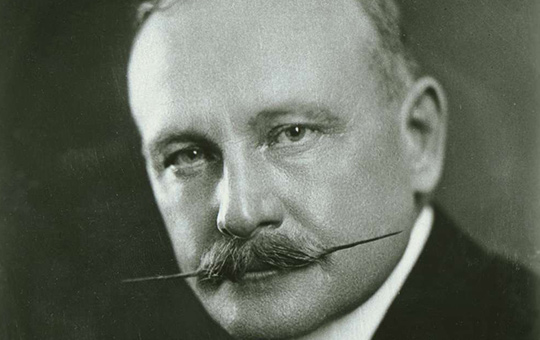
Vol. II / No. 1
By: George Byron Gordon
The Functions of the Modern Museum*
In its original significance the name MUSEUM was descriptive of the uses to which the place so named was appropriated. […]
View Article
Vol. II / No. 1
By: G. B. G.
Philae, The Forsaken: Egyptian Section
The modern books of travel in Egypt never fail to praise the beauty of Phil. The nineteenth century traveller on […]
View Article
Vol. II / No. 1
By: G.B.G.
A Trip to Chichen Itza: American Section
“The first description of (Chichen Itza is to be found in the notes of Diego de Landa, Bishop of Yucatan, […]
View Article
Vol. II / No. 1
By: F.G.S.
A Visit to the Penobscot Indians: American Section
The biennial election of governor, lieutenant-governor, representative, council and other officers of the Penobscot tribe of Indians took place last […]
View Article
Vol. II / No. 1
By: F.G.S.
Some Huron Treaty Belts: American Section
Several visits which I made among the Huron Indians at Loretto, P. Q., near Quebec, sonic years ago, gave me […]
View Article
Vol. II / No. 3
By: James A. Montgomery
A Magical Skull: Babylonian Section
A unique object is contained in the Museum collections from Nippur- a human skull the surface of which is inscribed […]
View Article
Vol. II / No. 3
By: Gerda Sebbelov
The E.W. Clark Collection: Polynesia: Section of General Ethnology
Among the objects belonging to the same group and to the same collection as those from New Zealand, which were […]
View Article
Vol. II / No. 3
By: Gerda Sebbelov
Mystery Packs of the American Indians: American Section
[The account of the Indian sacred bundles, used in the preparation of this article, has been furnished by Mr. M. […]
View Article
Vol. II / No. 3
By: Gerda Sebelov
The Osage War Dance: American Section
Little Mitanke’s son had died. He died from a drink, but his devoted father insisted on having the war dance […]
View Article
Vol. II / No. 4
By: Gerda Sebbelov
The E.W. Clark Collection: General Ethnology Section
New Caledonia Melanesia is the name given to a group of islands in the South Pacific lying directly to the […]
View Article
Vol. III / No. 1
By: George A. Barton
One of the Oldest Babylonian Tablets in the World
THE University Museum possesses one of the oldest Babylonian tablets in the world. There are but four other objects which […]
View Article
Vol. III / No. 1
By: M. R. Harrington
The Devil Dance of the Apaches
AMID the rugged foothills of the Wichita Mountains, on the military reservation at Fort Sill, Oklahoma, lives a remnant of […]
View Article
Vol. III / No. 1
By: M. R. Harrington
The Northwest Coast Collection
AN ethnological collection from the Indian tribes of the Northwest Coast of America, constituting a part of the George G. […]
View Article
Vol. III / No. 1
By: Gerda Sebbelov
Maori Face-Tattoo
A TATTOOED Maori head is becoming a rare thing. One large collection (the Robley Coll.) is owned by the Museum […]
View Article
Vol. III / No. 2
By: A.T. Clay
An Ancient Antiquary
The museum possesses a Babylonian tablet of baked clay, which has been secured by purchase. Unfortunately its provenance is unknown. […]
View Article
Vol. III / No. 2
By: James A. Montgomery
The Original Script of the Manichæans on Texts in the Museum
The writer has had more than once the opportunity of presenting to the readers of the JOURNAL an account of […]
View Article
Vol. III / No. 2
By: C. E. Keiser
Tags and Labels from Nippur
As clay was the common writing material among the Babylonians, it is quite possible to duplicate among the thousands of […]
View Article
Vol. III / No. 3
By: G. B. G.
The Museum and the Public School
ONE of the most interesting and useful developments in the activities of the Museum is the co-operative work which is […]
View Article
Vol. III / No. 3
By: E. H. Hall
The Cretan Expedition
THE story of the archaeological discoveries in Crete is now ten years old. Even our school-boys are learning to-day that […]
View Article
Vol. III / No. 4
By: E. H. H.
Two Black-Figured Amphoræ with Scenes Portraying the Birth of Athena
WHEN, in 1904, the great German archæologist, Adolf Furt-waengler, paid a visit to this Museum, his attention was attracted by […]
View Article
Vol. IV / No. 1
By: E. Torday
The New Congo Collection
During the summer of 1912 the Museum acquired by purchase a collection of about two thousand specimens consisting of weapons, […]
View Article
Vol. IV / No. 2
By: G. B. G.
Important Historical Documents Found in the Museum’s Collection of Ancient Babylonian Clay Tablets
In the spring of 1910 one hundred and fifteen boxes of inscribed tablets and fragments of tablets, excavated by the […]
View Article
Vol. IV / No. 2
By: Arno Poebel
The Babylonian Story of the Creation and the Earliest History of the World
During the summer of 1912 I examined the collections of cuneiform inscriptions in the University Museum. I was especially interested […]
View Article
Vol. IV / No. 2
By: George A. Barton
The Tablet of Enkhegal
Enkhegal was one of the earliest kings of Lagash, the modern Telloh. The only inscription from his time which is […]
View Article
Vol. IV / No. 2
By: James A. Montgomery
Abraham as the Inventor of an Improved Plow
In the Museum Journal, vol. I, p. 4, Prof. A.T. Clay published a reproduction and description of a most interesting […]
View Article
Vol. IV / No. 2
By: E. P. Wilkins
Napoleon’s Egypt
The President of the Museum, Mr. Eckley B. Coxe, Jr., has recently presented to the Museum Library a copy of […]
View Article
Vol. IV / No. 2
By: James A. Montgomery
The Lilith Legend
Among the magical texts in the Museum is the following, which belongs to a widespread category of Jewish charms: Shaddai […]
View Article
Vol. IV / No. 3
By: Louis Shotridge and Florence Shotridge
Indians of the Northwest
The Northwest Coast of America is inhabited by a number of Indian tribes who possess a culture differing in a […]
View Article
Vol. IV / No. 3
By: Florence Shotridge
The Life of a Chilkat Indian Girl
With the Chilkats, as with all the peoples of Southeastern Alaska, the training of a child was not a difficult […]
View Article
Vol. IV / No. 3
By: Geo. H. Pepper
An Indian Shrine
An Hidatsa shrine has been added to the Heye Collection. It represents one of the most interesting phases of the […]
View Article
Vol. IV / No. 3
By: M.R. Harrington
A Visit to the Otoe Indians
Although well known as an offshoot of the great Siouan stock, and as similar in dialect and habits to the […]
View Article
Vol. IV / No. 4
By: E. H. Hall
A Collection Made of Antique Glass
The process of making glass was invented, according to Pliny, in the following manner. ” That part of Syria which […]
View Article
Vol. IV / No. 4
By: E. H. Hall
A Roman Relief from Pozzuoli
In the last ten years an attempt has been made to reinstate Roman art in the proud place it occupied […]
View Article
Vol. IV / No. 4
By: E. H. H.
Attic Vases from Orvieto
In 1897, through the generosity of Mr. John Wanamaker, the Museum secured two boxes of fragments of antique vases which […]
View Article
Vol. IV / No. 4
By: E. H. H.
A Red-Figured Kylix: Graeco-Roman Section
Among the objects which have been cleaned during the summer of 1913 and from which modern restorations have been removed […]
View Article
Vol. IV / No. 4
By: E. H. H.
A Seated Dionysos
The last addition to the Lucy Wharton Drexel collection of Roman sculpture acquired only a short time before the death […]
View Article
Vol. V / No. 1
By: G.B.G
Dr. S. Weir Mitchell
Many days have passed since the world heard of Dr. S. Weir Mitchell’s death. From all quarters have come the […]
View Article
Vol. V / No. 1
By: G. B. G.
Some New Exhibits
In the recent history of museum development in America and Europe the accession of collections has been so much more […]
View Article
Vol. V / No. 1
By: G. B. G.
Some Art Objects From Tibet
In the last number of the JOURNAL mention was made of the purchase of a number of rare objects from […]
View Article
Vol. V / No. 1
By: G. B. G.
Chinese Ceramics
During the last summer the Museum acquired a number of selected pieces of pottery and porcelain from China. The ethnological […]
View Article
Vol. V / No. 1
By: J. G.
An Imperial Chinese Sceptre
A rare example of Chinese art recently acquired is to be seen in the new exhibits. It is a Chinese […]
View Article
Vol. V / No. 1
By: E. H. H.
A Neo-Attic Relief and a Roman Portrait Head
Two marbles, acquired by the Museum in the autumn of 1913, are now on exhibition in the newly arranged room […]
View Article
Vol. V / No. 1
By: E. H. H.
A Red-Figured Amphora Signed by the Potter Meno
The Museum has had in its possession since 1896 a red-figured amphora decorated with two scenes which for precision, delicacy, […]
View Article
Vol. V / No. 1
By: E. H. H.
A Red-Figured Stamnos of the Periklean Period
Throughout the history of Attic vases, a subject frequently employed by the potters for the painted scenes which decorated their […]
View Article
Vol. V / No. 2
By: E. H. H.
A Granite Sphinx From Memphis
OF all the hybrid creatures, half man and half beast, which are represented in ancient art, the most famous is […]
View Article
Vol. V / No. 2
By: G. B. G.
The Alexander Scott Collection
This is Part 1 of 4 of The Alexander Scott Collection article, which has been divided into sections for clarity. […]
View Article
Vol. V / No. 2
By: Alexander Scott
Buddhistic Art: The Alexander Scott Collection
This is Part 2 of 4 of The Alexander Scott Collection article, which has been divided into sections for clarity. […]
View Article
Vol. V / No. 2
By: Alexander Scott
A Carved Ivory Tablet and Some Other Examples of Buddhistic Art: The Alexander Scott Collection
This is Part 3 of 4 of The Alexander Scott Collection article, which has been divided into sections for clarity. […]
View Article
Vol. V / No. 2
By: Lama Dousand Up
Notes By Dousand Up: The Alexander Scott Collection
This is Part 4 of 4 of The Alexander Scott Collection article, which has been divided into sections for clarity. […]
View Article
Vol. V / No. 2
By: E. H. H.
A Colored Marble Statuette
In 1901 the Museum purchased in Rome a statuette of colored marble representing a woman in rapid motion, her drapery […]
View Article
Vol. V / No. 2
By: E. H. Hall
Two Marbles from Lake Nemi
Fifteen miles southeast of Rome in the midst of wooded hills lies Lake Nemi, the gem of the Alban Mountains. […]
View Article
Vol. V / No. 2
By: E. H. H.
A Roman Portrait Head
When in 1882 Bernoulli was compiling his publication of Roman portraits, he was able to cite nine examples of a […]
View Article
Vol. V / No. 3
By: C. W. B.
A Pottery Statue of a Lo-han
One of the most striking characters in Chinese history, ancient or modern, is Shih Huang Ti, of the Ch’in dynasty—the […]
View Article
Vol. V / No. 3
By: C. W. B.
Two Sculptured Chinese Heads
The lately acquired stone heads of Buddha and Kuan-yin, dating, as they do, from a time when Chinese sculpture was […]
View Article
Vol. V / No. 3
By: S. Langdon
A New Sumerian Document
During the autumn of 1913, Prof. Stephen Langdon of Jesus College, Oxford, holding the Shillito chair of Assyriology in that […]
View Article
Vol. V / No. 3
By: E. H. H.
Examples of Mycenæan and Minoan Art
In response to the universal interest in the recent discoveries in Crete, the Museum has acquired reproductions not only of […]
View Article
Vol. V / No. 3
By: E. H. H.
A Bronze Blade from the Dictæan Cave, Crete
In 1886 word was brought to the authorities in Candia that peasants of the Lasithe plain in eastern Crete had […]
View Article
Vol. V / No. 4
By: G. B. G.
The Year at the Museum
The chief event that marks the history of the Museum during 1914 is the successful completion of the building operations […]
View Article
Vol. V / No. 4
By: C. W. B.
Tibetan Sacred Art
Illustrated By Two Tibetan Paintings In The Museum. There appears at first sight. little by which to distinguish the sacred […]
View Article
Vol. V / No. 4
By: C. W. B.
A Masamune Blade
Among the recent acquisitions of the Museum is a sword which there is good reason to believe was forged by […]
View Article
Vol. V / No. 4
By: E. H. H.
A Pair of Bits from Corneto
In the fourth book of the Iliad after Pandaros has succeeded in sending an arrow through the fastening of Menelaos’s […]
View Article
Vol. V / No. 4
By: E. H. H.
Some Greek and Italian Vases in the Museum
An Ionic Amphora In 1896 the Museum purchased a group of eight vases which had once belonged to Tewfik Pasha, […]
View Article
Vol. V / No. 4
By: E. H. H.
Fresco Representing a Hunt, from the Later Palace at Tiryns
No site in prehistoric Greece is more familiar than the citadel of Tiryns, the gray rock of which rises sheer […]
View Article
Vol. VI / No. 1
By: George A. Barton
Kings Before the Flood
Among the valuable texts published by Dr. Poebel in Volume V of the Publications of the Babylonian Section of the […]
View Article
Vol. VI / No. 2
By: E. H. H.
Two Black-Figured Amphorae from Orvieto
Two black-figured amphorae in the Museum are here for the first time adequately illustrated. One, Figs. 68 and 69, has […]
View Article
Vol. VI / No. 2
By: William Curtis Farabee
Conebo Pottery
The Conebo is one of several related tribes occupying the territory along the Alto-Ucayali River speaking dialects of the Pano […]
View Article
Vol. VI / No. 3
By: G. B. G.
Guatemala Myths*
In Guatemala are many high mountains and many fertile valleys with beautiful lakes and running streams. Nowhere in the world […]
View Article
Vol. VI / No. 4
By: B. W. M.
The Copper Eskimo
When Stefansson was making his ethnological researches among the Eskimo of Coronation Gulf, he met Captain Joseph Bernard, who, with […]
View Article
Vol. VI / No. 4
By: S. B. L.
An Attic Black-Figured Panel-Amphora in the University Museum
In 1896 the Museum obtained a small group of Greek vases, which are said to have come from the Greek […]
View Article
Vol. VI / No. 4
By: E. H. D.
Four Covered Bowls From Orvieto
MENTION has frequently been made in the pages of this JOURNAL of the fragments of Greek vases, which were found […]
View Article
Vol. VII / No. 1
By: S. B. L.
Five Roman Mosaics
In 1904 Mrs. Dillwyn Parrish of London presented to the Museum in memory of her husband, the late Mr. Dillwyn […]
View Article
Vol. VII / No. 1
By: G. B. G.
The Double Axe and Some Other Symbols
The origin and development of symbolism, letters, and designs used in decoration either with or without symbolic meaning is a […]
View Article
Vol. VII / No. 2
By: S. B. L.
A Greek Torso
One of the latest acquisitions of the Museum is a marble torso between 50 and 75 centimeters in height, which […]
View Article
Vol. VII / No. 2
By: B. W. M.
Some Ojibway Buffalo Robes
Recently an elaborately painted buffalo robe was presented to the Museum by Mrs. Harry Wain Harrison, in whose family it […]
View Article
Vol. VII / No. 2
By: C. W. B
The Expedition to the Far East
In planning the University Museum’s Eastern Asiatic Expedition, or, more properly speaking, reconnaissance, it was considered desirable to study the […]
View Article
Vol. VII / No. 2
By: B. W. M.
Wampum
In studying the culture of the American Indians one is surprised at the many ingenious devices used. Many of the […]
View Article
Vol. VII / No. 3
By: A. H. Sayce
Oriental Art in the University Museum
The University Museum has on exhibition a collection representing the art of the Far East, which, though not as large […]
View Article
Vol. VII / No. 3
By: C. W. B.
Notes on Chinese Statuary
It would perhaps be too much to say that but for the Buddhist faith there would have been no art […]
View Article
Vol. VII / No. 3
By: S. L.
Ishtar’s Journey to Hell
The legend of the journey of Ishtar to the lower world, in quest of her lover, the dying god of […]
View Article
Vol. VII / No. 3
By: H. U. H.
The Bagobo
Some Notes on a Lately Acquired Collection “The owners of these islands,” says an old writer, speaking of the Southern […]
View Article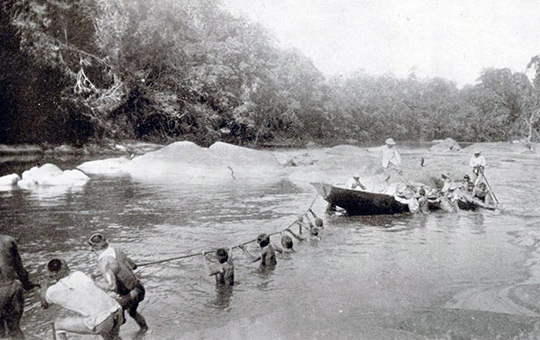
Vol. VII / No. 4
By: W. C. F.
The Amazon Expedition of the University Museum
The Indians of South America are physically so similar to those of North America, and so unlike any other possible […]
View Article
Vol. VII / No. 4
By: C. W. B.
Two Early Chinese Buddhist Sculptures
Few examples of early Chinese sculpture are more widely known than are the two Buddhist pedestals recently acquired by the […]
View Article
Vol. VII / No. 4
By: S. H. L.
An Ancient Babylonian Map
Among the collections in the Babylonian Section of the Museum is a clay tablet upon which an ancient engineer drew […]
View Article
Vol. VII / No. 4
By: S. B. L.
A Red-Figured Pyxis
The vase which forms the subject of this article is one of the latest acquisitions of the Mediterranean Section of […]
View Article
Vol. VIII / No. 1
By: Stephen B. Luce, Jr.
An Attic Grave Stele
One of the most important pieces of Greek sculpture that has come to America in recent years has just been […]
View Article
Vol. VIII / No. 1
By: Stephen B. Luce, Jr.
A Group Of Greek Vases
During the year 1916 the Mediterranean Section of the University Museum acquired six vases of great importance. One of these, […]
View Article
Vol. VIII / No. 1
By: Stephen Langdon
The Epic Of Gilgamish
In the year 1914 the University Museum acquired by purchase a Babylonian tablet of quite exceptional interest and importance. It […]
View Article
Vol. VIII / No. 1
By: Stephen Langdon
A Ritual Of Atonement for a Babylonian King
In Babylonian religion the rituals of the private confessional and atonement were characterized by mystic and magic ceremonies accompanied by […]
View Article
Vol. VIII / No. 1
By: Clarence S. Fisher
Excavations At Gizeh
The Eckley B. Coxe, Jr., Expedition to Egypt The Royal Cemetery of Gizeh occupies many acres of the high plateau […]
View Article
Vol. VIII / No. 1
By: H. U. Hall
Some Gods of the Yoruba
The Yoruba tribes of the hinterland of Lagos in the Western Province of Southern Nigeria were formerly united in a […]
View Article
Vol. VIII / No. 1
By: WM. Curtis Farabee
The Amazon Expedition of the University Museum
To the Head Waters of the Amazon After returning from the Guianas, we made a journey of 2,200 miles up […]
View Article
Vol. VIII / No. 2
By: Louis Shotridge
My Northland Revisited
Mr. Louis Shotridge, the author of this article, was born at the old Indian town of Kluckwan on the Chilkat […]
View Article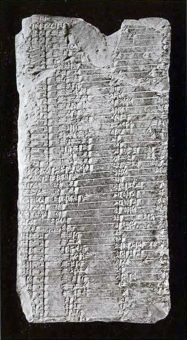
Vol. VIII / No. 2
By: Stephen Langdon
A Babylonian Dream Tablet on the Interpretation of Dreams
Revelation of future events by dreams formed an important discipline in the ancient science of divination. The subject was treated […]
View Article
Vol. VIII / No. 2
By: B. W. Merwin
A Voodoo Drum from Hayti
During the first three centuries of colonization of the New World many of the native customs and beliefs of West […]
View Article
Vol. VIII / No. 2
By: Wm. Curtis Farabee
The Amazon Expedition
The Tapajos Our next long journey was made up the Tapajos River, to the state of Matto Grosso, where the […]
View Article
Vol. VIII / No. 2
By: Stephen B. Luce, Jr.
The Exploits Of Herakles, on Greek Vases in the University Museum
The recent acquisition of an Attic black-figured amphora by the Museum, with a painting of Herakles fighting the Amazons, has […]
View Article
Vol. VIII / No. 3
By: Stephen Langdon
A New Tablet of the Cult of Deified Kings in Ancient Sumer
The tendency to worship extraordinary mortals upon whom senates and municipal governments bestowed the rank of divinity has more or […]
View Article
Vol. VIII / No. 3
By: B. W. Merwin
Dutch Guiana Pottery
There have been many changes in Dutch Guiana since 1498, when Columbus first saw its shores. White pirates, explorers seeking […]
View Article
Vol. VIII / No. 3
By: Stephen B. Luce. Jr.
A Greek Jointed Doll
Through the generosity of Miss Alice M. Freeman, the University Museum has recently acquired a little terra cotta of extraordinary […]
View Article
Vol. VIII / No. 3
By: Stephen B. Luce. Jr.
A Loan Of Three Greek Vases
The Museum has had the good fortune to secure a very interesting loan of three Greek vases, all in good […]
View Article
Vol. VIII / No. 4
By: Clarence Stanley Fisher
The Eckley B. Coxe Jr. Egyptian Expedition
Memphis. In the MUSEUM JOURNAL for June, 1915, a brief account was given of the preliminary work of the Eckley […]
View Article
Vol. Supplement / No. 1917
By: G. B. Gordon
Report of the Director for the Year 1917
To the Contributing Members of the University Museum The Museum started the year which is now coming to a close […]
View Article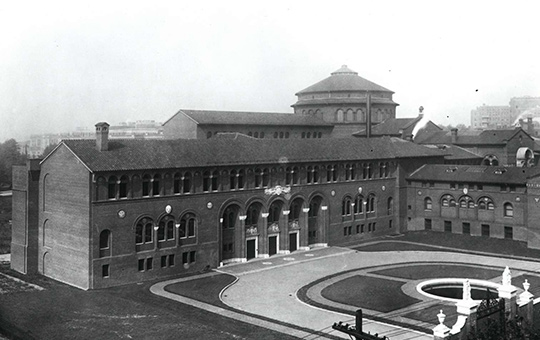
Vol. IX / No. 1
By: G. B. Gordon
Foreword
One of the vital truths made clear by collections that illustrate the history of the arts is the essential identity […]
View Article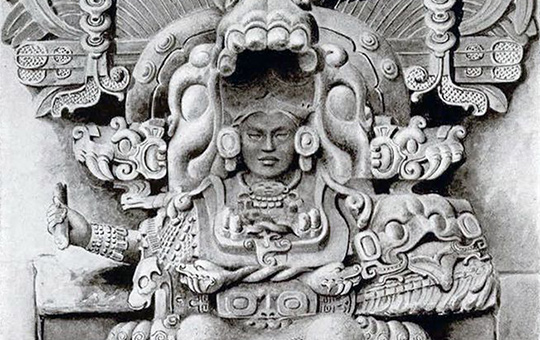
Vol. IX / No. 1
By: G. B. Gordon
Native American Art
This number of the JOURNAL is devoted to the subject of American Art, the native production untouched by outside influences. […]
View Article
Vol. IX / No. 1
By: G. B. Gordon
The Trail Of The Golden Dragon
Before asking you to follow me on the trail of the Golden Dragon, I want to say in order to […]
View Article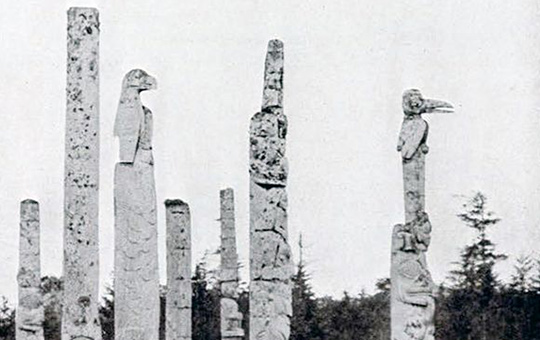
Vol. IX / No. 1
By: G. B. Gordon
Legends Of Kit-Selas
These stories were told to me in the summer of 1917 by Walter Wright and I wrote them down. Walter […]
View Article
Vol. IX / No. 1
By: B. W. Merwin
The Art of Quillwork
Among the Indian women of America the arts and crafts took a prominent place as an occupation and as a […]
View Article
Vol. IX / No. 1
By: Wm. C. Farabee
Decorative Arts Of The Amazon
In common use the term “art” is confined to the designation of the Fine Arts and is limited in its […]
View Article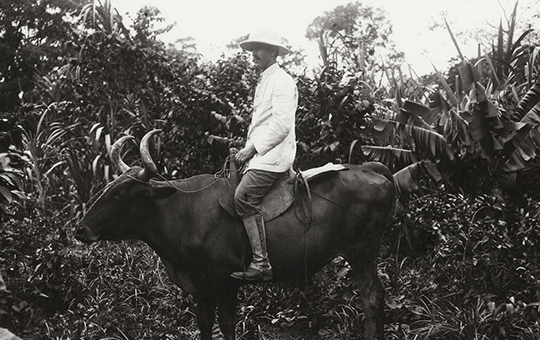
Vol. IX / No. 1
By: Wm. C. Farabee
The Marriage of the Electric Eel
In the discussion of the art of the Amazon it was stated that the realistic figures had no social nor […]
View Article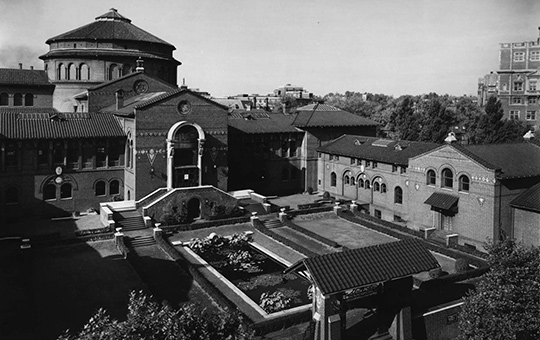
Vol. IX / No. 2
By: G. B. Gordon
Foreword
This number of the JOURNAL calls attention to some of the ancient thoughts and ancient works of man in the […]
View Article
Vol. IX / No. 2
By: C. W. Bishop
Two Chinese Bronze Vessels
The Museum has recently acquired through the generosity of a patron two antique bronze vessels of such rarity and importance […]
View Article
Vol. IX / No. 2
By: C. W. Bishop
Recent Accessions Of Chinese Sculpture
It is becoming steadily more evident as archæological study progresses that advancement in the arts of civilized life is as […]
View Article
Vol. IX / No. 2
By: A. H. Sayce
The Museum Collection Of Cappadocian Tablets*
Title Reference* The collection of Cappadocian tablets in the University Museum which I have recently examined and copied has furnished […]
View Article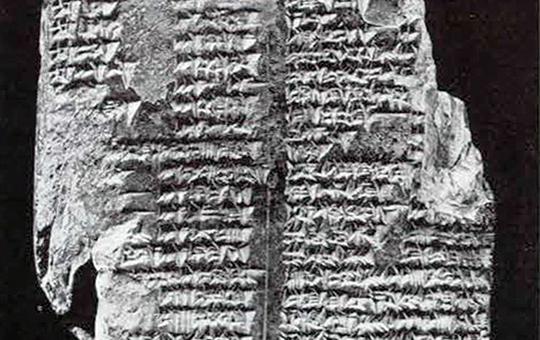
Vol. IX / No. 2
By: Stephen Langdon
A Tablet On The Mysteries Of Babylonian Symbolism*
Title reference When I was examining a certain tablet of the Nippur collection in the Museum for the purpose of […]
View Article
Vol. IX / No. 2
By: Stephen Langdon
A Sumerian Liturgy Containing an Ode to the Word
The discovery in the collection of Babylonian tablets in the Museum of a tablet containing an Ode to the Word […]
View Article
Vol. IX / No. 3-4
By: G. B. Gordon
Foreword
When I was a King and a Mason—a Master proven and skilled—I cleared me ground for a palace such as […]
View Article
Vol. IX / No. 3-4
By: Theodoor De Booy
The People Of The Mist
An Account of Explorations in Venezuela The journey which I am about to describe had two objects in view; to […]
View Article
Vol. IX / No. 3-4
By: B. W. Merwin
The Patty Stuart Jewett Collection
The late Mrs. H. K. Jewett, of Pasadena, California, a daughter of George H. Stuart, of Philadelphia, was for many […]
View Article
Vol. IX / No. 3-4
By: C. W. Bishop
The Horses of T’ang T’ai-Tsung
Of the Antecedents of the Chinese Horse Before attempting to describe the series of reliefs so widely known as the […]
View Article
Vol. IX / No. 3-4
By: Robert Burkitt
The Hils and the Corn
A Guatemala Myth From Robert Burkitt The Museum has recently recieved from Mr. Burkitt a myth of the Kekchi Indians […]
View Article
Vol. X / No. 1-2
By: Chas. C. Harrison
International Revenue Act Of 1918
Exempts From All Federal Estate Inheritance Taxes Bequests to the University Museum To the Benefactors and Friends of the University […]
View Article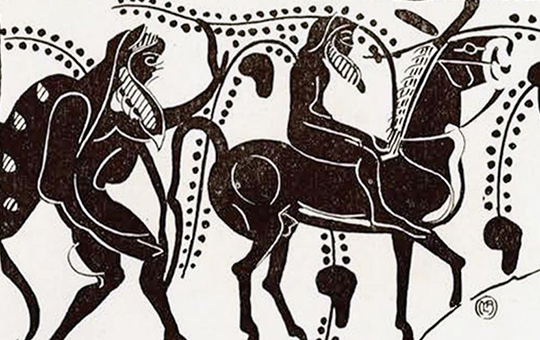
Vol. X / No. 1-2
By: Eleanor F. Rambo
On The Design Of Greek Vases
To the voices uplifted in encouragement of a fresh interest in design may the classicist venture to add a treble […]
View Article
Vol. X / No. 1-2
By: Eleanor F. Rambo
An Attic Black-Figured Skyphos
This vase was acquired by the University Museum early in 1918. Of its previous history nothing is known. Peculiar interest […]
View Article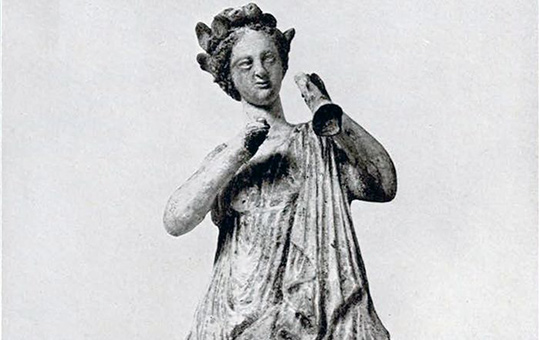
Vol. X / No. 1-2
By: Stephen B. Luce
A Tanagra Figurine
The University Museum has recently acquired by purchase a very interesting Tanagra figurine. Of its authenticity there can be no […]
View Article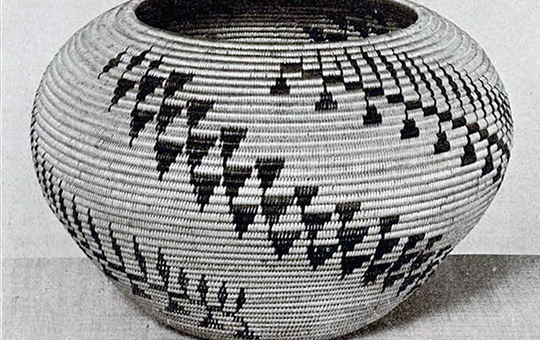
Vol. X / No. 1-2
By: G. B. Gordon
The Richard Waln Meirs Collection
The American Section of the Museum has been fortunate lately in receiving gifts of several important collections. The latest accession […]
View Article
Vol. X / No. 1-2
By: B. W. Merwin
Basketry Of The Chitimacha Indians
A Gift from Mrs. William Pepper. One of the most interesting and least known tribes of American Indians is the […]
View Article
Vol. X / No. 1-2
By: H. U. Hall
A Marshall Islands Chart
Presented to the Museum by the Honorable John Wanamaker As all the world knows, Robert Louis Stevenson lived and died […]
View Article
Vol. X / No. 1-2
By: Louis Shotridge
War Helmets and Clan Hats of the Tlingit Indians
This article, as well as the one following on “A Visit to the Tsimshian Indians,” was written by Louis Shotridge, […]
View Article
Vol. X / No. 1-2
By: Louis Shotridge
A Visit To The Tsimshian Indians
The Naas River From the last week in the month of August, 1918, to the last week of October of […]
View Article
Vol. X / No. 3
By: Wm. C. Farabee
The Apalaii
After floating with the tide up the Amazon River for several days in a small canoe we turned north into […]
View Article
Vol. X / No. 3
By: Louis Shotridge
A Visit To The Tsimshian Indians
The Skeena River (Continued) On the evening of the first day in Terrace, I learned from the few Indians wandering […]
View Article
Vol. X / No. 3
By: Eleanor F. Rambo
A Group Of Funerary Stelae
. . . “thy work, touched by the common need, Serenely effigied upon this tomb, With the sure seal of […]
View Article
Vol. X / No. 3
By: Eleanor F. Rambo
The John Thompson Morris Collection of Glass
In ancient times and for long thereafter the invention of glass was accredited to the Phoenicians. As Pliny tells the […]
View Article
Vol. X / No. 3
By: Wm. C. Farabee
Indian Children’s Burial Place In Western Pennsylvania
While at Waynesburg to deliver a Fourth of July address, I took advantage of the opportunity to spend a few […]
View Article
Vol. X / No. 4
By: Wm. C. Farabee
Mummified Jivaro Heads
The custom of taking the head, eyes, scalp, hands, teeth, or other part of the body as a trophy was […]
View Article
Vol. X / No. 4
By: H. U. Hall
New Ireland Masks
There are in the collections of the University Museum numerous objects which illustrate very fairly the life and manners of […]
View Article
Vol. X / No. 4
By: H. U. Hall
Shaminist Bird Figures of the Yenisei Ostyak
When the whole destinies of a people are, as they believe, dependent upon the action, helpful or harmful, of spirits, […]
View Article
Vol. X / No. 4
By: Louis Shotridge
Keyt-Gooshe “Killer Whales Dorsal Fin”
The picturesque ideas of the Tlingit people of Southeastern Alaska are well illustrated by the painted batons used in conducting […]
View Article
Vol. X / No. 4
By: Stephen B. Luce
Early Vases From Apulia
I. Pre-Hellenic Pottery One of the most fascinating problems confronting the classical scholar, be he philologist, historian, or archæologist, is […]
View Article
Vol. XI / No. 1
By: Louis Shotridge
Ghost Of Courageous Adventurer
The arts of the Tlingit Indians follow very closely upon tradition, and having recourse to imagination as well as observation, […]
View Article
Vol. XI / No. 1
By: H. U. Hall
Fetish Figures Of Equatorial Africa
The Museum is about to open a new exhibition of African and South Pacific Art and the time is appropriate […]
View Article
Vol. XI / No. 1
By: Stephen B. Luce
Attic Vases From Orvieto
In the MUSEUM JOURNAL for December, 1913, an article appeared, in which a large number of vases were published, that […]
View Article
Vol. XI / No. 1
By: Stephen B. Luce
Ancient Helmets From Italy
During the war it was a commonplace subject of conversation, and of articles in the newspapers and magazines, that for […]
View Article
Vol. XI / No. 1
By: Wm. C. Farabee
A Newly Acquired Wampum Belt
It is a well-known fact that wampum, or shell money, was in general use throughout the Atlantic coast in very […]
View Article
Vol. XI / No. 2
By: Dr. Eleanor E. Rambo
Crete
Crete, sometimes aptly called “the halfway house between Egypt and Greece,” was, during the third and second millenia B.C., the […]
View Article
Vol. XI / No. 2
By: Dr. Eleanor E. Rambo
Antiquities From Cyprus
Case V. Case V is devoted to Cypriote vases and crude sculptures. The culture of Cyprus is distinct from that […]
View Article
Vol. XI / No. 2
By: Dr. Eleanor E. Rambo
Greek Vases
The first distinctly Hellenic pottery fabric is the geometric. It is generally considered to be not a decided break from […]
View Article
Vol. XI / No. 2
By: Dr. Eleanor E. Rambo
Italian Fabrics
After the destruction of the Athenian Empire at the hands of Sparta, Athens lost control of the potter’s trade. Some […]
View Article
Vol. XI / No. 2
By: Dr. Eleanor E. Rambo
The Italic Collection
The Etruscans The Italic Collection comprises pottery, bronzes, terra cottas and jewelry. It is far the largest collection in the […]
View Article
Vol. XI / No. 2
By: Dr. Eleanor E. Rambo
Ancient Roman Glass
The University Museum is fortunate in possessing a very good collection of ancient Roman glass. The term “Roman” is here […]
View Article
Vol. XI / No. 2
By: Dr. Eleanor E. Rambo
Greek and Roman Sculpture
The collection of sculpture includes Greek originals, Roman reliefs and Roman copies of Greek originals, and Roman portrait heads. There […]
View Article
Vol. XI / No. 2
By: Dr. Eleanor E. Rambo
Ægean Fresco Paintings
The Ægeans made one very important contribution to the development of technique in art in their invention of fresco painting. […]
View Article
Vol. XI / No. 2
By: Dr. Eleanor E. Rambo
Ægean Metal Work
The Ægeans were cunning workers in metal. Especially the lords of Mycenae, “rich in gold,” gathered about them fine specimens […]
View Article
Vol. XI / No. 2
By: Dr. Eleanor E. Rambo
Reproduction of Ægean Vases and Lamps
On brackets in alcove C are reproductions of Cretan lamp stands, found at Knossos and dated vaguely in the period […]
View Article
Vol. XI / No. 2
By: Dr. Eleanor E. Rambo
Reproduction of Offerings to the Cretan Snake Goddess
Very little is known of the religion of the prehistoric Cretans. Like many primitive peoples, they seem to have worshiped […]
View Article
Vol. XI / No. 2
By: Dr. Eleanor E. Rambo
Ancient Jewelry
The goldsmith’s craft is one of the oldest arts in the Mediterranean world. That is to say, it is one […]
View Article
Vol. XI / No. 2
By: Dr. Eleanor E. Rambo
Miscellaneous Bronze Objects
In case X has been arranged a collection of miscellaneous bronze objects, ranging in date from the sixth to the […]
View Article
Vol. XI / No. 2
By: Dr. Eleanor E. Rambo
Terra Cotta and Bronze Figurines
Of ancient terra cottas in general it has most aptly been said that they are a peculiar phase of minor […]
View Article
Vol. XI / No. 2
By: Dr. Eleanor E. Rambo
The John Thompson Morris Collection of Coins and Medals
At the present writing, this room contains also four tables of coins and medals—The John Thompson Morris Collection. About one-fourth […]
View Article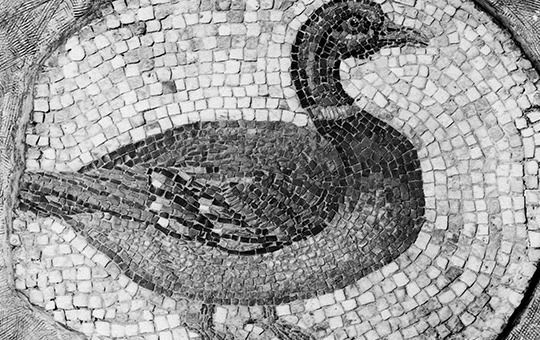
Vol. XI / No. 2
By: Dr. Eleanor E. Rambo
Ancient Roman Mosaics
Greeks as well as Egyptians knew the art of decorating walls and especially pavements with bits of stone, terra cotta […]
View Article
Vol. XI / No. 3
By: Wm. Curtis Farabee
Ancient American Gold
The objects described in this article comprise the main part of an exhibition that was shown to invited guests of […]
View Article
Vol. XI / No. 3
By: V. Scheil
The Oldest Written Code
In a volume of SELECTED SUMERIAN AND BABYLONIAN TEXTS published by the University Museum, Henry Frederick Lutz has carefully copied, […]
View Article
Vol. XI / No. 3
By: Leon Legrain
Nippur’s Gold Treasure
As the goddess of love Ishtar descended into Hades in quest of her youthful lover Tammuz, she had to divest […]
View Article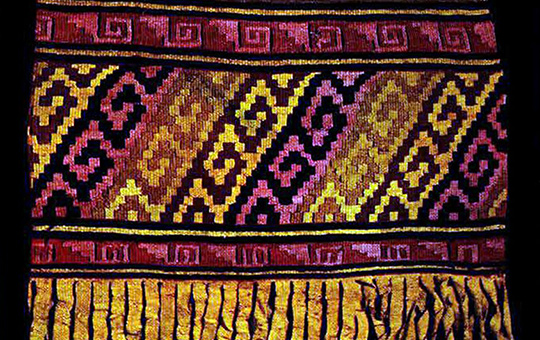
Vol. XI / No. 3
By: Ethel Ellis Benners
Ancient Peruvian Textiles
Considering the enormous wealth of decorative material to be found in prehistoric Peruvian art it is strange more frequent use […]
View Article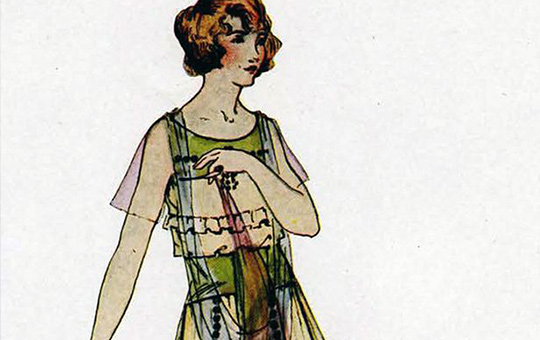
Vol. XI / No. 3
By: Lucile Howard
The Museum: Its Relation to Modern Design
The mission of any great museum includes among many activities two that are related to my present purpose. First to […]
View Article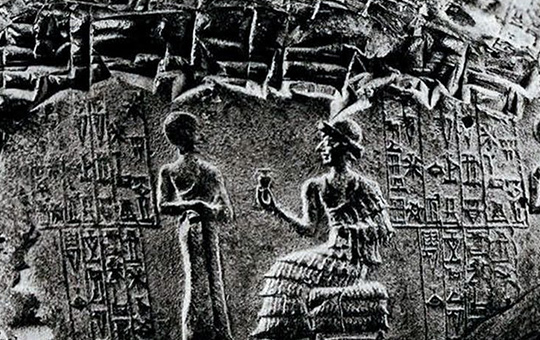
Vol. XI / No. 4
By: Leon Legrain
Reconstructing Ancient History
I Portrait of a King Who Reigned 4130 Years Ago Ibi-Sin, the last king of Ur, began to reign in […]
View Article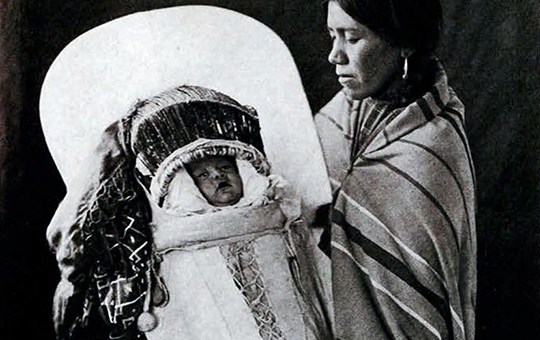
Vol. XI / No. 4
By: William Curtis Farabee
Indian Cradles
The long period of infancy has been the one stabilizing influence in the foundation of human society. Around the mother […]
View Article
Vol. XI / No. 4
By: Henry Usher Hall
Maori Wood Carving and Moko
The objects dealt with in this article form part of the exhibition lately arranged in the southeast room on the […]
View Article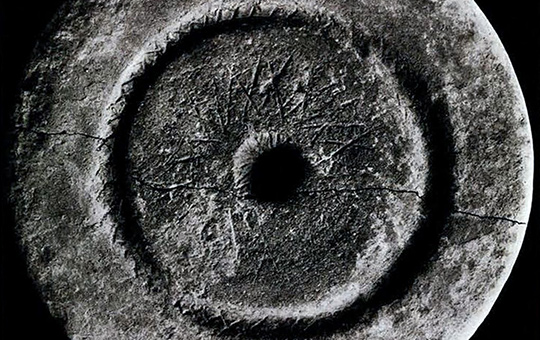
Vol. XI / No. 4
By: Stephen Bleeker Luce Jr
An Early Potter’s Wheel
No clearer evidence is known to the archæologist as to the civilization of any early people, than the pottery which […]
View Article
Vol. XII / No. 1
By: Henry Usher Hall
A Book of Tapa
In the year 1787 there was published in London an interesting and curious book styled a CATALOGUE and illustrated with […]
View Article
Vol. XII / No. 1
By: Clarence S. Fisher
The Throne Room of Merenptah
In the JOURNAL for December, 1917, a summary was given of the excavations in the palace of Merenptah at Memphis, […]
View Article
Vol. XII / No. 1
By: William Curtis Farabee
The Use of Metals in Prehistoric America
As long as prehistoric man was held down to the use of bone and stone implements he could make very […]
View Article
Vol. XII / No. 1
By: William Curtis Farabee
A Golden Hoard from Ecuador
The fine collection of prehistoric American Indian gold objects from Ecuador in the University Museum was found in 1912 by […]
View Article
Vol. XII / No. 1
By: George Byron Gordon
The Ulua Marble Vases
In the Central American collections in the Museum is a group of marble vases from the Ulua Valley in Honduras […]
View Article
Vol. XII / No. 1
By: Leon Legrain
A New Fragment of Chronology
THE DYNASTY OF AGADE. At a few months interval, our material for reconstructing the early Sumerian chronology has been increased […]
View Article
Vol. XII / No. 2
By: C. W. Bishop
Shantung, China’s Holy Land
Not chance alone has brought Shantung, instead of some other of China’s Eighteen Provinces, to the fore at the late […]
View Article
Vol. XII / No. 3
By: George Byron Gordon
Baalbek
Lecture Delivered at the University Museum, January 15, 1921 The boundaries of the new Syria where it fronts the eastern […]
View Article
Vol. XII / No. 3
By: William Curtis Farabee
Explorations at the Mouth of the Amazon
Of the whole drainage of the Amazon, the great island of Marajo, lying in its mouth like an egg in […]
View Article
Vol. XII / No. 3
By: Louis Shotridge
Tlingit Woman’s Root Basket
Before me stands an old American Indian basket, it is a production of my own people. As I look and […]
View Article
Vol. XII / No. 3
By: Henry Usher Hall
Woodcarvings of the Austral Islands
A prominent feature of the exhibition of Polynesian artifacts in the General Ethnology Section of the Museum is a number […]
View Article
Vol. XII / No. 3
By: Edith Hall Dohan
An Archaic Head from Cyprus
Fig. 69. Archaic Head from Cyprus. Museum Object Number: MS5674 Image Number: 26390 Fig. 70. Profile of Fig. 69. Museum […]
View Article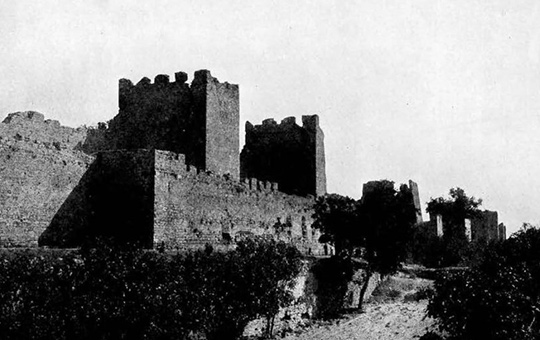
Vol. XII / No. 4
By: George Byron Gordon
The Walls of Constantinople: A Lecture Delivered at the University Museum on Nov. 26, 1921
There are two ways of reaching Constantinople at present. One is by the Orient Express, leaving Paris and passing by […]
View Article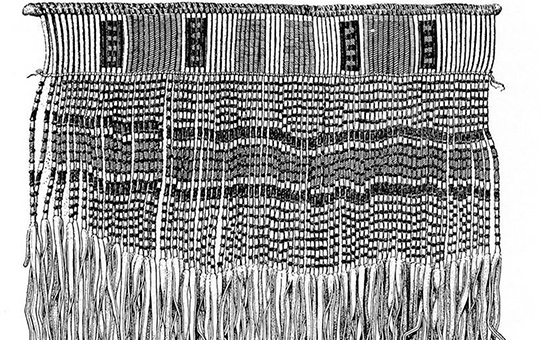
Vol. XII / No. 4
By: William Curtis Farabee
Dress Among Plains Indian Women
THE culture of the Plains Indians was characterized by a lack of practically everything we today consider essential in the […]
View Article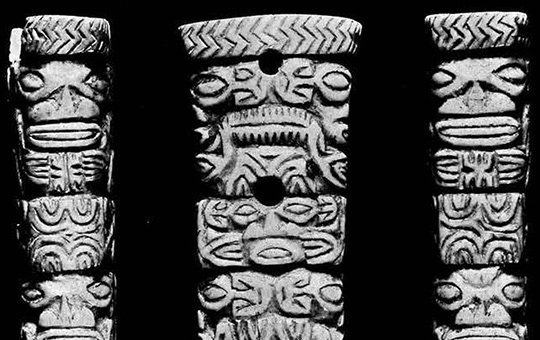
Vol. XII / No. 4
By: Henry Usher Hall
Art of the Marquesas Islanders
IN the year 1595, the Spanish admiral, Alvaro de Mendaña, sailing westward from Peru in command of an expedition sent […]
View Article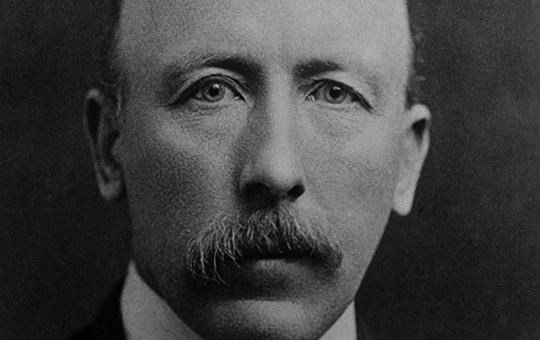
Vol. XIII / No. 1
By: Sir Frederic Kenyon
The British Museum Policy
The following abstract of an address by Sir Frederic Kenyon, Director of the British Museum, delivered before the Society of […]
View Article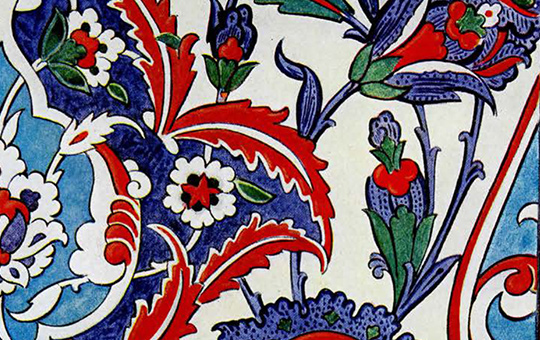
Vol. XIII / No. 1
By: George Byron Gordon
Arabic Art: This is not a treatise on Arabic Art but a notice directing attention to some examples in the University Museum that I obtained at Cairo and Damascus in 1919.
The terms Mohammedan Art, Arabic Art and Saracenic Art are used by different writers to describe the work of artists […]
View Article
Vol. XIII / No. 1
By: Clarence S. Fisher
Beth-Shean
THE Beth-shean of Scripture, called Scythopolis by the Greeks and now the little village of Beisan, has been an object […]
View Article
Vol. XIII / No. 1
By: William Curtis Farabee
Recent Discovery of Ancient Wampum Belts
During the summer of 1921, Doctor Gordon, the Director ofthe Museum, in company with Doctor Leon Legrain, paid a visit […]
View Article
Vol. XIII / No. 1
By: Louis Shotridge
Land Otter-Man
The title of this article is not that of a myth, but a name of a war canoe. The canoe […]
View Article
Vol. XIII / No. 1
By: Leon Legrain
Five Royal Seal Cylinders
I The Oldest Dated Royal Seal. The Seal of Basha-Enzu, B. C. 2900. ART and history are interested in this […]
View Article
Vol. XIII / No. 1
By: Eleanor F. Rambo
Stories on Greek Vases: Notes of Some Vases in the University Museum
Any handbook on Greek vases, every general discussion of them, posits the statement that the vases are of the highest […]
View Article
Vol. XIII / No. 2
By: George Byron Gordon
Foreword
Prior to 1912 the University Museum possessed a group of 19 small objects from Great Benin presented by Mr. Ling […]
View Article
Vol. XIII / No. 2
By: Henry Usher Hall
Great Benin Royal Altar
The juju or fetish altar which has lately been installed in the African room is designed to exhibit in something […]
View Article
Vol. XIII / No. 3
By: George Byron Gordon
Foreword
A city teeming with life, however ancient, does not rouse the interest of archaeologists like the mounds of Memphis or […]
View Article
Vol. XIII / No. 3
By: George Byron Gordon
List of Selected Books: Ancient London
John Stow—A Survey of London (1598). The great work on Mediaeval London and the first History of the City. It […]
View Article
Vol. XIII / No. 3
By: George Byron Gordon
I. The Geology of London: Ancient London
The accumulations that mark the progress of a city are closely related to the geological sequence in the earth’s surface. […]
View Article
Vol. XIII / No. 3
By: George Byron Gordon
II. Men of the Stone Age, Celt and Roman: Ancient London
London’s Continuity In the days before the antiquarians and the scholars began their violent invasion of the provinces held so […]
View Article
Vol. XIII / No. 3
By: George Byron Gordon
III. Some Medieval Monuments-Their Associations: Ancient London
Saxon and Dane Of Saxon London, few traces are to be seen today except in the Museums. The Chapel of […]
View Article
Vol. XIII / No. 4
By: George Byron Gordon
IV. In The Approaches to The City: Ancient London
Temple Bar Adjacent to the Temple in Fleet Street and sharing its traditions are or were many ancient landmarks with […]
View Article
Vol. XIII / No. 4
By: George Byron Gordon
V. In The Byways: Ancient London
Neville’s Court I find it more pleasant to call attention to some old houses that still survive and I have […]
View Article
Vol. XIII / No. 4
By: George Byron Gordon
VI. The Women of London: Ancient London
“As for the Women of the City, they are Sabines.” In these words of praise Fitzstephen wrote with feeling of […]
View Article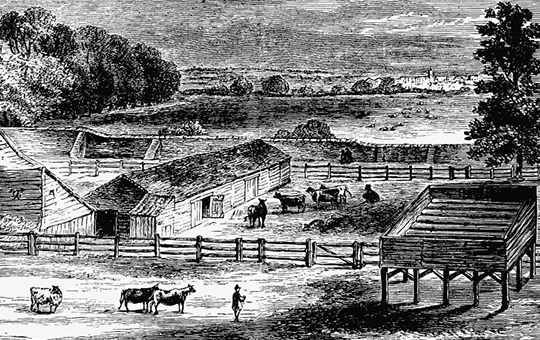
Vol. XIII / No. 4
By: George Byron Gordon
VII. Tyburn: Ancient London
Sometimes on a clear morning after rain if you happen to cross Green Park you may see a streak of […]
View Article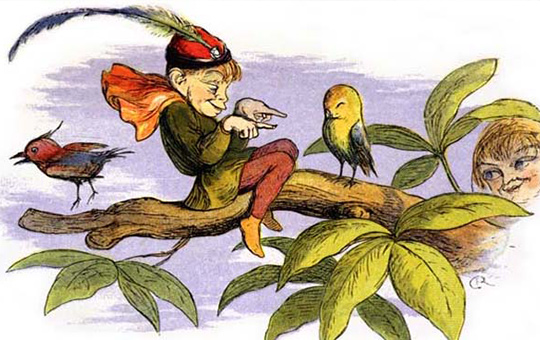
Vol. XIII / No. 4
By: George Byron Gordon
VIII. Merrie England: Ancient London
Now it might be supposed by someone reading these brief abstracts relating to Tyburn that life in ancient London was […]
View Article
Vol. XIII / No. 4
By: George Byron Gordon
IX. The Lord Mayor and The Livery: Ancient London
Wherever there is in the world a City speaking the English language, with wards, with municipal government consisting of Mayor, […]
View Article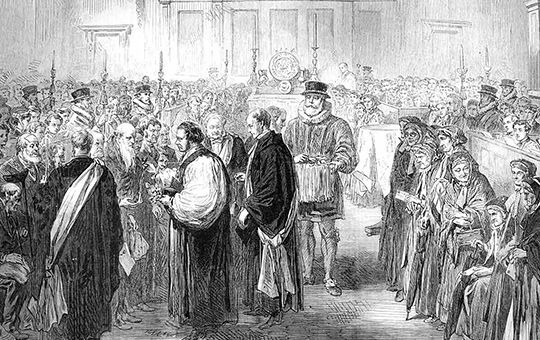
Vol. XIII / No. 4
By: George Byron Gordon
X. Ancient Customs: Ancient London
Of the many scores of ancient customs that keep alive the memory of other days, marshalling the Middle Ages in […]
View Article
Vol. XIII / No. 4
By: George Byron Gordon
XI. Westminster: Ancient London
Westminster is a Metropolitan borough. It is also a City and its formal name is the City of Westminster. In […]
View Article
Vol. XIII / No. 4
By: George Byron Gordon
XII. Whitehall: Ancient London
3rd Gentleman. So she parted, And with the same full state paced back again, To York where the feast is […]
View Article
Vol. XIII / No. 4
By: George Byron Gordon
XIII. Residential London and The Boroughs: Ancient London
Chelsea Chelsea leads its charming life beside the Thames, not oblivious of the distinguished lives it has harboured but quite […]
View Article
Vol. XIII / No. 4
By: George Byron Gordon
XIV. London Bridge: Ancient London
London Bridge is falling down, Falling down, falling down. Old Nursery Rhyme One day in the summer of 1921, the […]
View Article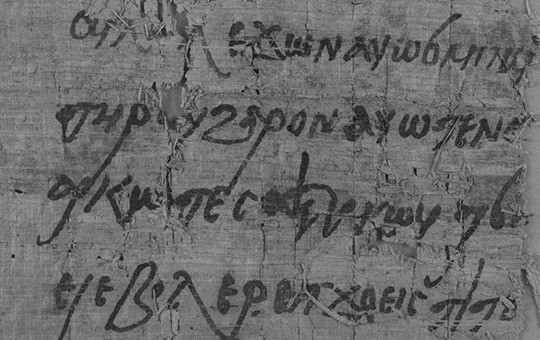
Vol. XIV / No. 1
By: Dr. Nathaniel Reich
A Notary of Ancient Thebes
In the important collection of Demotic papyri recently discovered by the Museum’s Expedition at Thebes, there is one document which […]
View Article
Vol. XIV / No. 1
By: George Byron Gordon
A Fine Chinese Stela in the Museum
The votive stela recently acquired by the Museum is one of exceptional interest and importance. Its outline and proportions are […]
View Article
Vol. XIV / No. 1
By: Henry Usher Hall
Two Hawaiian Feather Garments, Ahuula
Two beautiful and remarkably well preserved examples of the gorgeous feather garments formerly worn by chiefs in the Hawaiian Islands […]
View Article
Vol. XIV / No. 1
By: Henry Usher Hall
Congo and West African Woodcarvings
In earlier volumes of the JOURNAL we have published some description of the Museum’s Collection of West African and Congo […]
View Article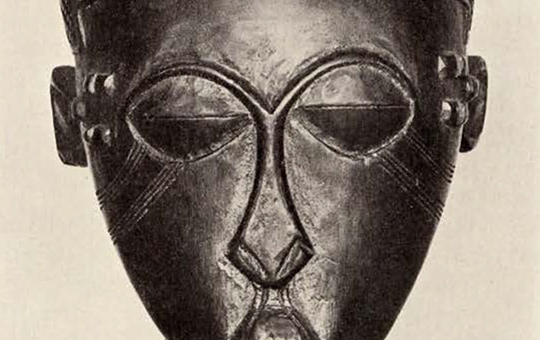
Vol. XIV / No. 2
By: Henry Usher Hall
Notes on Some Congo and West African Woodcarvings
II. The Southern Congo: Interior Between Lakes Tanganyika and Mweru in the east and the neighbourhood of the Kwango River […]
View Article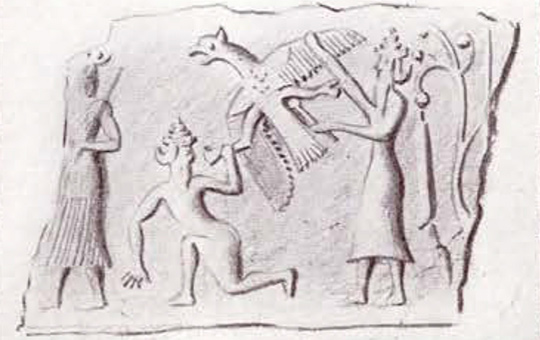
Vol. XIV / No. 2
By: Leon Legrain
Some Seals of the Babylonian Collections
The seals and seal impressions are the real jewels of the Babylonian Collections of the Museum. Up to the present […]
View Article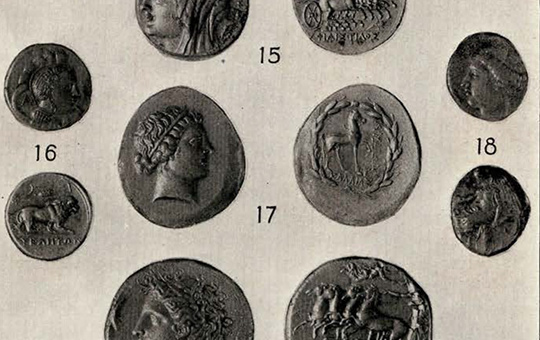
Vol. XIV / No. 2
By: Edith Hall Dohan
Coins from Magna Græcia and Sicily
Coins are generally classed with the products of the Minor Arts, those arts which beautify the things man “handles and […]
View Article
Vol. XIV / No. 3
By: Henry Usher Hall
Ancient Man in the Charente
It is in France, and notably in the south and southwest, that we have the fullest and most nearly continuous […]
View Article
Vol. XIV / No. 3
By: H. U. Hall
A Baluba Chieftain’s Staff
IN the last number of the MUSEUM JOURNAL there appeared among several other objects from the Southern Congo two fine […]
View Article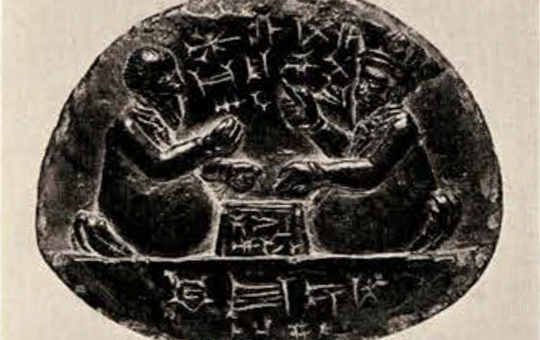
Vol. XIV / No. 3
By: Leon Legrain
Darius and the Pseudo Smerdis: A Green Jade Relief. CBS. 14543
WHILE Cambyses led the Persian Army in Egypt, he was frightened by an obscure oracle at Buto, and sent back […]
View Article
Vol. XIV / No. 3
By: Leon Legrain
The Inscriptions of the Kings of Agade: The Missing Fragment of the Nippur Tablet. CBS. 13972
ABOUT B. c. 2600, a scribe of the temple of Enlil at Nippur who had the training of an historian, […]
View Article
Vol. XIV / No. 4
By: Clarence S. Fisher
Bethshean: Excavations of the University Museum Expedition, 1921-1923
Those who had an interest in history or archaeology realized to some extent its great strategic value in the constant […]
View Article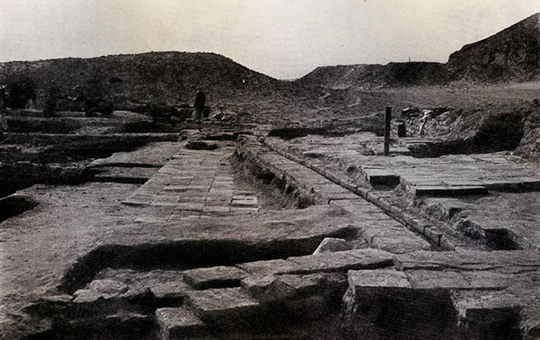
Vol. XIV / No. 4
By: G.B Gordon
The Excavations at Ur
The Preliminary Report of Mr. C.L. Woolley in charge of the work of the joint expedition of the British Museum, […]
View Article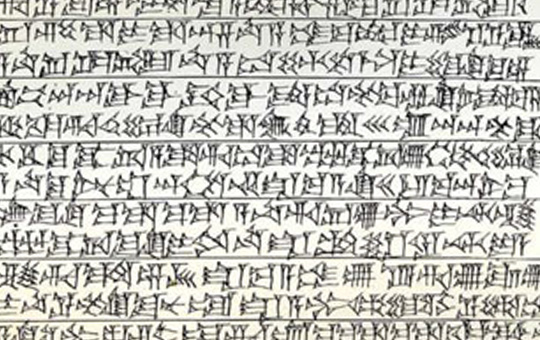
Vol. XIV / No. 4
By: Leon Legrain
The Golden Boats of Marduk and Nabu in Babylon
Cylinder of Nebuchadnezzar.Museum Object Number: B9 One of the finest and for several reasons a unique document of Nebuchadnezzar, king […]
View Article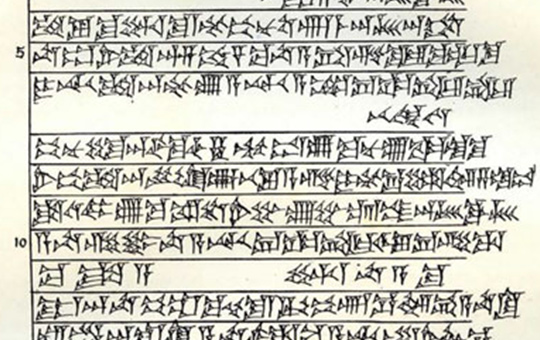
Vol. XIV / No. 4
By: Leon Legrain
King Nabonidus and the Great Walls of Babylon
THE extension of the walls of the great city of Babylon after King Nabuchadnezzar is a vexed question, which may […]
View Article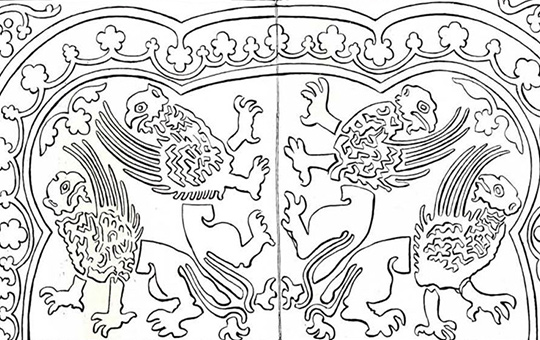
Vol. XIV / No. 4
By: G.B. Gordon
The Floor Tiles of Westminster Abbey Chapter House
THE old English floor tiles made at the beginning of the 13th century and as late as the 16th century […]
View Article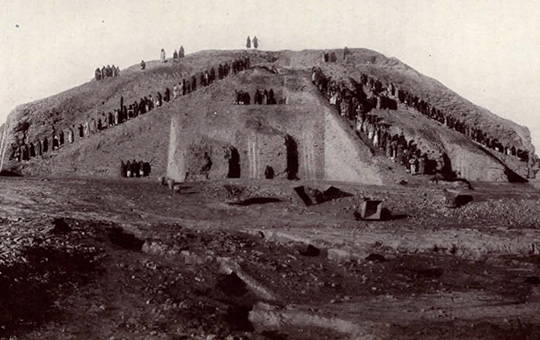
Vol. XV / No. 1
By: C. Leonard Woolley
The Expedition to Ur
The Joint Expedition of the British Museum and the University Museum to Mesopotamia resumed excavations at Ur of the Chaldees […]
View Article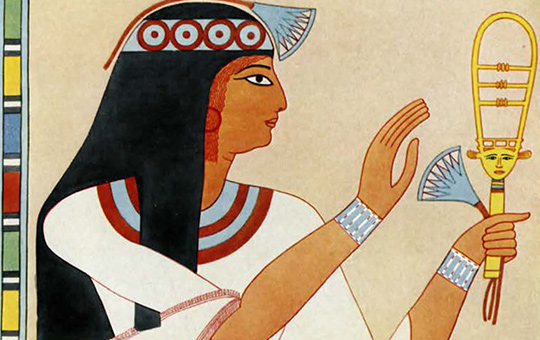
Vol. XV / No. 1
By: Clarence S. Fisher
A Group of Theban Tombs: Work of the Eckley B. Coxe Jr. Expedition to Egypt
During the winter seasons of 1921-22 and 1922-23 the University Museum chose for its field of operations in Egypt a […]
View Article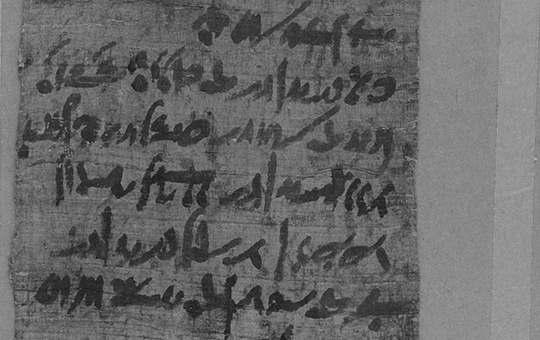
Vol. XV / No. 1
By: Nathaniel Reich
Marriage and Divorce in Ancient Egypt: Papyrus Documents discovered at Thebes by the Eckley B. Coxe Jr. Expedition to Egypt.
There existed not only in our present day, but also in ancient times, many examples of confirmed bachelors. Such an […]
View Article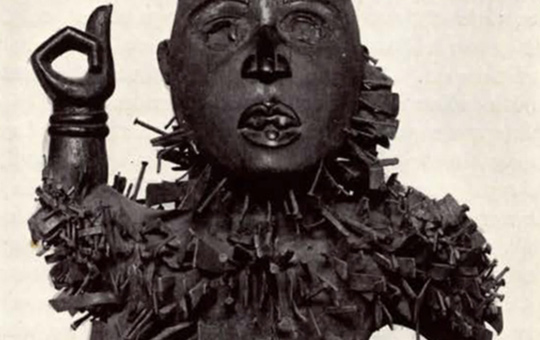
Vol. XV / No. 1
By: Henry Usher Hall
A Congo Fetish: Or Divining Image From the Coast Region
This very interesting and important wooden statuette, of a class commonly referred to as nail fetishes for a reason which […]
View Article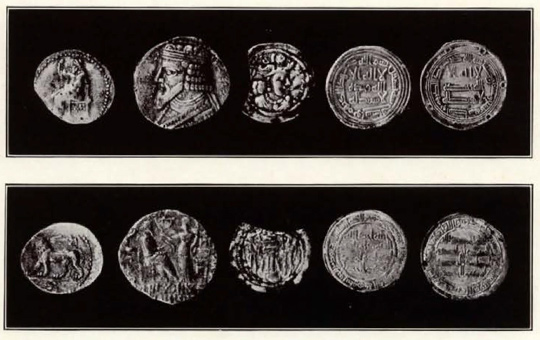
Vol. XV / No. 1
By: Leon Legrain
Coins From Nippur
Ancient coins have the double charm of history and beauty. A special interest is attached to the present coins, which […]
View Article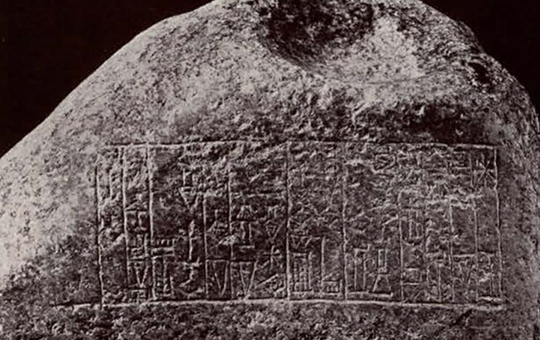
Vol. XV / No. 1
By: Leon Legrain
Two Door Sockets of the Kings of Ur
Many temples, walls, stage towers and shrines of Babylonia were restored by order of the kings of Ur, B. C. […]
View Article
Vol. XV / No. 1
By: George Byron Gordon
The Westminster Tiles
In the last number of the JOURNAL in describing the floor tiles in the Chapter House of Westminster Abbey I […]
View Article
Vol. XV / No. 2
By: Clarence S. Fisher
Merenptah’s Throne Room
Brief accounts of the excavation and a reconstruction of the throne room of the Merenptah palace at Memphis have already […]
View Article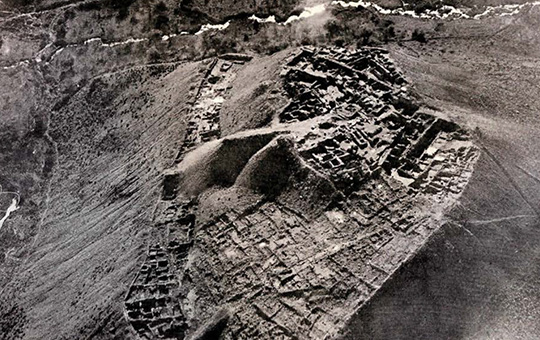
Vol. XV / No. 2
By: Clarence S. Fisher
The Expedition to Palestine: Beisan as Seen from the Air, Royal Air Force Photographs
NOTE.—The services to archaeology rendered by the Royal Air Force in the Middle East were briefly referred to in the […]
View Article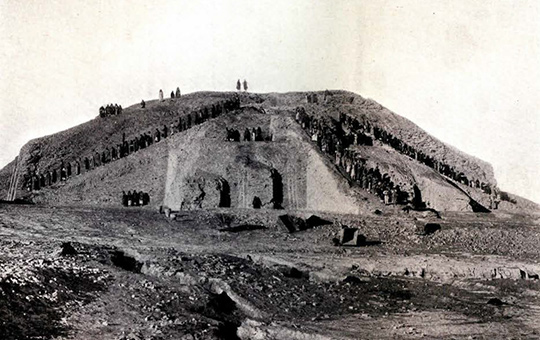
Vol. XV / No. 2
By: C. Leonard Woolley
The Ziggurat of Ur: From the Report of the Joint Expedition of the British Museum University Museum to Mespotomia.
During the whole of our digging season (1923-24) the greater number of the workmen have been engaged upon the clearing […]
View Article
Vol. XV / No. 2
By: Robert Burkitt
A Journey in Northern Guatemala
After riting to you from Chocolá, I went up to Kesaltenango: where I got a copy, which haz been useful […]
View Article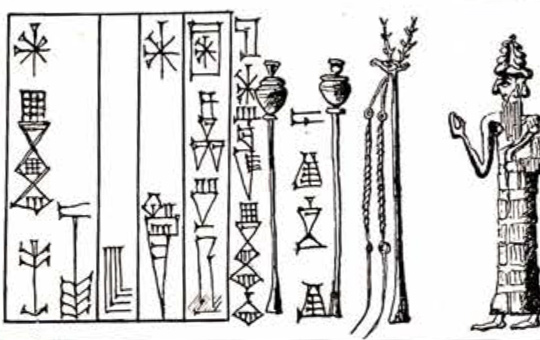
Vol. XV / No. 3
By: Leon Legrain
The Art Of The Oldest Civilization Of The Euphrates Valley
The wonderful discoveries made at Ur and Tell el Obeid by the Joint Expedition of the British Museum and the […]
View Article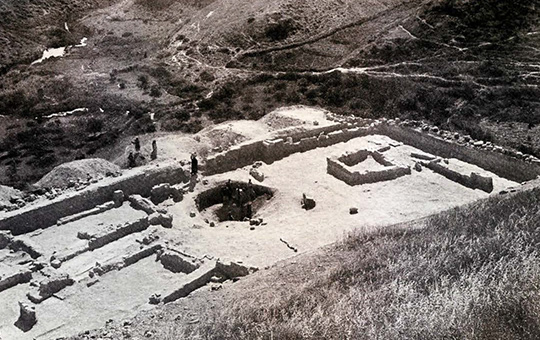
Vol. XV / No. 3
By: Clarence S. Fisher
The Church At Beisan: Discoveries By The Expedition To Palestine
In the JOURNAL for December, 1923, Dr. Fisher described the excavations at Beisan. The present article has particular reference to […]
View Article
Vol. XV / No. 3
By: Henry Usher Hall
African Cups Embodying Human Forms
I Among a number of small bronze objects in the University Museum, hitherto unpublished, from the old kingdom of Benin […]
View Article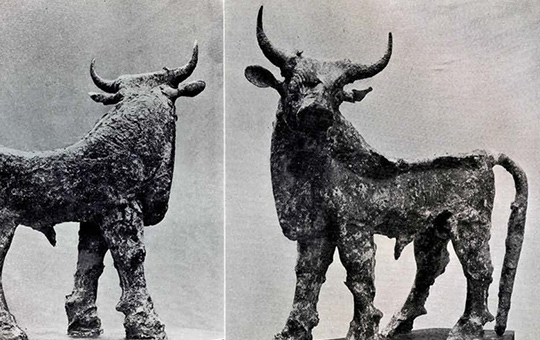
Vol. XV / No. 4
By: C. Leonard Woolley
The Excavations at Tell El Obeid
Tell El Obeid1 is a small isolated mound lying some four miles W.N.W. of Ur on the line of an […]
View Article
Vol. XV / No. 4
By: Henry Usher Hall
The Orator’s Staff
Among the Maori of New Zealand and in the Samoan islands oratory had a peculiarly privileged position among the arts. […]
View Article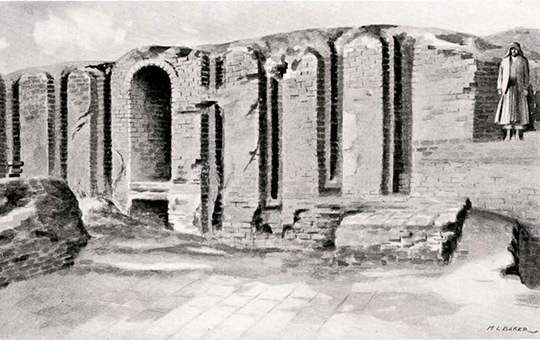
Vol. XVI / No. 1
By: C. Leonard Woolley
The Expedition To Ur: Director of the Joint Expedition of the British Museum and the University Museum, to Mesopotamia
At the beginning of November, 1924, the Joint Expedition of the British Museum and the University Museum resumed work for […]
View Article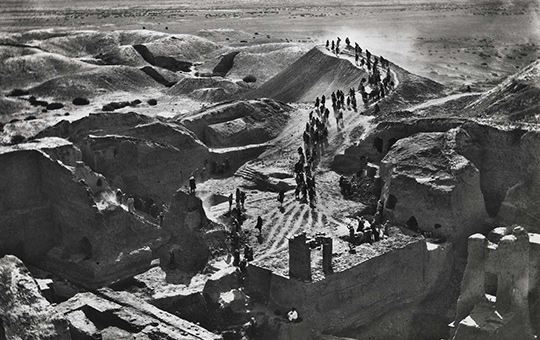
Vol. XVI / No. 1
By: C. Leonard Woolley
A Great Temple Of Babylonia: Director of the Joint Expedition of the British Museum and the University Museum, to Mesopotamia
More and more clearly as the work of excavation goes on at Ur of the Chaldees do we see the […]
View Article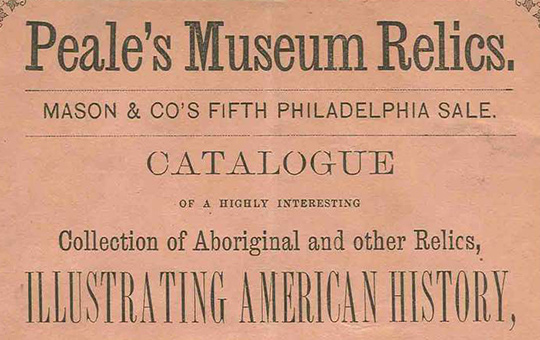
Vol. XVI / No. 1
By: Henry Usher Hall
A Link With The Old Peale Museum
Three years ago, in searching the accession book of the old Peale Museum, which is preserved among the Historical Society […]
View Article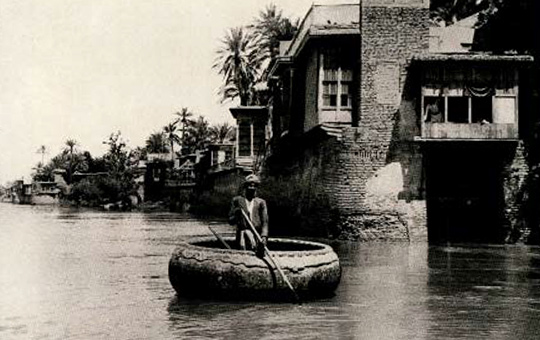
Vol. XVI / No. 2
By: Leon Legrain
The Joint Expedition To Ur Of The Chaldees
As I leave Marseille on the SS. Lotus on October 1, 1924, sharp north wind. which they call “lou mistral,” […]
View Article
Vol. XVI / No. 2
By: Henry Usher Hall
A Woodcarving From Easter Island
The object figured here from the Museum’s Easter Island collection belongs to a class, of woodcarvings usually referred to in […]
View Article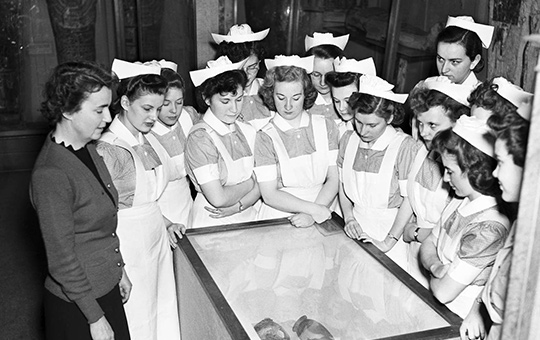
Vol. XVI / No. 2
By: Helen E. Fernald
The Educational Department Of The Museum-Its Functions
Art education in the schools was the field toward which most teachers and leaders were looking hopefully about ten years […]
View Article
Vol. XVI / No. 3
By: Helen E. Fernald
Mortuary Figures Of The T’ang Dynasty
On May 22, 1925, there was opened to invited guests of the Museum an Exhibition of Chinese Art which included […]
View Article
Vol. XVI / No. 3
By: Henry Usher Hall
A Souvenir Of The Great Explorers
The University Museum has recently received from Alaska an object of quite extraordinary interest, found in an Indian village on […]
View Article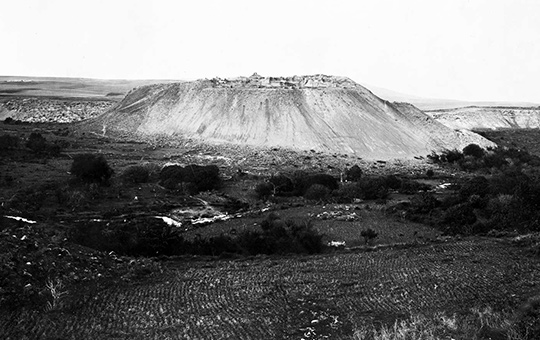
Vol. XVI / No. 4
By: Alan Rowe
Discovery Of The Temple Of Ashtaroth: Report Of The Expedition To Palestine
And it came to pass on the morrow, when the Philistines came to strip the slain, that they found Saul […]
View Article
Vol. XVII / No. 1
By: Henry Usher Hall
A Buffalo Robe Biography
The museum has lately acquired a painted buffalo robe of that interesting class which provides pictorial records of the warlike […]
View Article
Vol. XVII / No. 1
By: Henry Usher Hall
Some Shields Of The Plains And Southwest
The hero of the pictorial record of Plains Indian life described elsewhere in the present number of the JOURNAL carries […]
View Article
Vol. XVII / No. 1
By: Helen E. Fernald
Three Ming Pottery Figures
Vistors to the University Museum have noticed for some time past a group of three pottery statuettes in the Chinese […]
View Article
Vol. XVII / No. 1
By: Helen E. Fernald
Some Chinese Grave Figures
I Introduction Mention was made in a recent article in THE MUSEUM JOURNAL1 of some Chinese grave figurines which have […]
View Article
Vol. XVII / No. 1
By: Ananda K. Coomaraswamy
A Statuette Of Vishnu From Kashmir
The Museum of the University of Pennsylvania is the fortunate possessor of a very finely sculptured and well preserved statuette […]
View Article
Vol. XVII / No. 2
By: J. Alden Mason
Dr. Farabee’s Last Journey
Four centuries ago to this very year, in 1526, a handful of men stood on the deck of a tiny […]
View Article
Vol. XVII / No. 2
By: Henry Usher Hall
Alfred Collins In The Congo: A Photographic Record Of Daily Life With Introduction And Notes
These notes were compiled from information kindly furnished to me by Mr. Collins and from such references as I could […]
View Article
Vol. XVII / No. 3
By: Helen E. Fernald
Chinese Frescoes Of The T’ang Dynasty In The Museum: 618-906 A. D.
The Museum has recently acquired three colossal Chinese frescoes which, we may state without exaggeration, are among the most important […]
View Article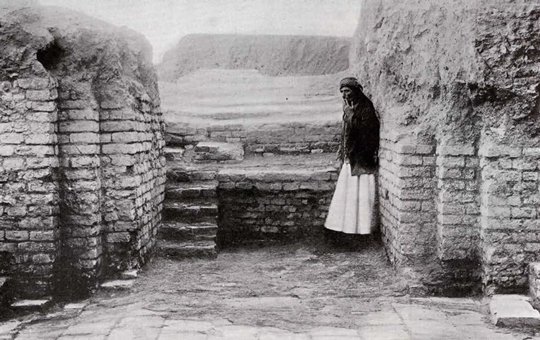
Vol. XVII / No. 3
By: Leon Legrain
The Pilgrim Of The Moon At Ur Of The Chaldees: Concerning the Fourth Campaign of the Joint Expedition of the Museum of the University of Pennsylvania and the British Museum.
I The pilgrim on an archaeological quest, on his journey to Ur observes that the signs on the face of […]
View Article
Vol. XVII / No. 3
By: J. Alden Mason
Additions To The American Section
I A Peruvian Aryballus By gift of Mr. F. C. Durant the Museum has acquired an excellent and unusually large […]
View Article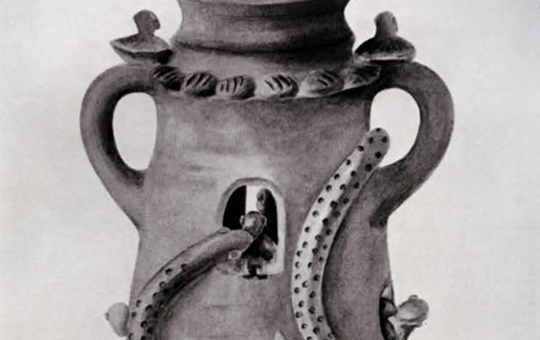
Vol. XVII / No. 3
By: Alan Rowe
The Temples Of Dagon And Ashtoreth At Beth-Shan
During the campaign of 1925-26 the Museum’s Expedition at Beisan, ancient Beth-Shan in Palestine, discovered altogether four Canaanite temples, two […]
View Article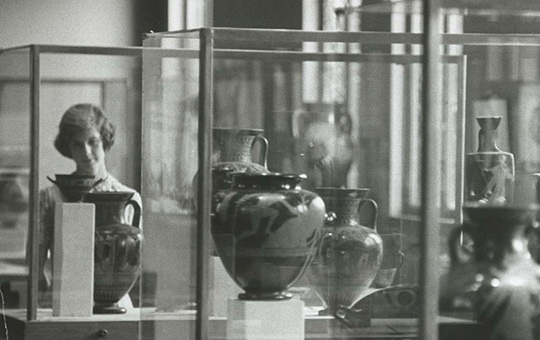
Vol. XVII / No. 3
By: Mrs. Loring Dam
What Is A Docent?
The idea of a Museum as a place for frequent and leisurely hours of aesthetic entertainment seems to be strange […]
View Article
Vol. XVII / No. 4
By: Helen E. Fernald
Ancient Chinese Musical Instruments: As Depicted On Some Of The Early Monuments In The Museum
Illustrations by the Author* Among the Chinese collections of the University Museum there are a number of figures representing musicians […]
View Article
Vol. XVII / No. 4
By: Leon Legrain
The Tragic History Of Ibi-Sin, King Of Ur
During the last two seasons at Ur, and especially during the recent campaign, the Joint Expedition of the Museum of […]
View Article
Vol. XVII / No. 4
By: J. Alden Mason
A Collection From The Crow Indians
Among the Indian tribes of our Great Plains, those buffalo hunting, tipi inhabiting, feather bedecked, upstanding warriors who to us […]
View Article
Vol. XVII / No. 4
By: Henry Usher Hall
An Ivory Standing Cup From Benin
The illustration on the opposite page shows an old carved ivory object, now in this Museum, from Great Benin, the […]
View Article
Vol. XVIII / No. 1
By: Charles C. Harrison
Dr. George Byron Gordon
It is not an easy duty to write for the MUSEUM JOURNAL some account of DOCTOR GEORGE BYRON GORDON and […]
View Article
Vol. XVIII / No. 1
By: Alan Rowe
The Discoveries At Beth-Shan During The 1926 Season
The excavations conducted at Beisan, the biblical Beth-Shan, by the Palestine Expedition of the Museum of the University of Pennsylvania, […]
View Article
Vol. XVIII / No. 1
By: Dr. J. Alden Mason
Native American Jades
JADE, that exquisite stone of emerald hue, translucent and of almost gem-like hardness, has ever been sought, prized and almost […]
View Article
Vol. XVIII / No. 1
By: Dr. Leon Legrain
The Stela of the Flying Angels
I THE great stela of King Ur-Nammu has been called by Mr. C. Leonard Woolley in his successive reports of […]
View Article
Vol. XVIII / No. 1
By: H. U. Hall
Two Wooden Statuettes From the Lower Congo
I. A Nail Fetish from the Maritime Congo A REMARKABLE example of this class of fetishes, which is so characteristic […]
View Article
Vol. XVIII / No. 1
By: Helen E. Fernald
A Note on the Chinese Stela of 551 A.D.
THIS stela was published in the MUSEUM JOURNAL for March, 1923. At that time the scene represented in relief in […]
View Article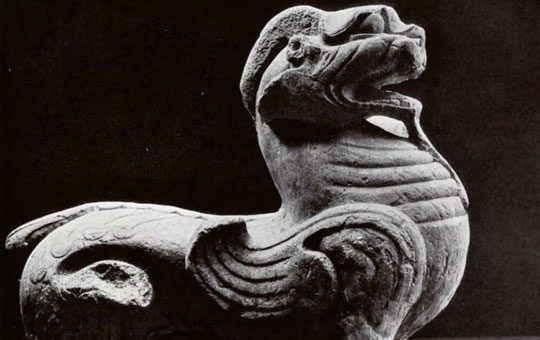
Vol. XVIII / No. 2
By: Helen E. Fernald
Two Colossal Stone Chimeras from a Chinese Tomb
A FEW years ago the attention of archaeologists was called to the remains of an old cemetery about six miles […]
View Article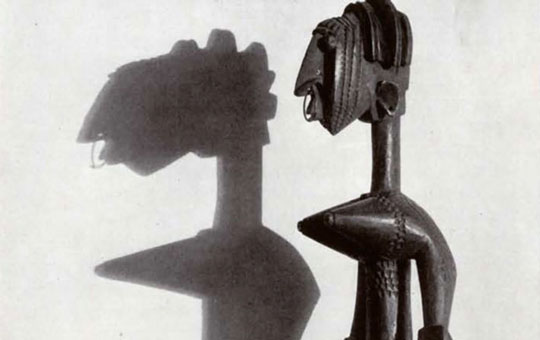
Vol. XVIII / No. 2
By: H. U. Hall
Two Wooden Statuettes from French West Africa
THE Museum has recently added to its collections representing the wood-sculpture of Upper Guinea several remarkable examples from French territory […]
View Article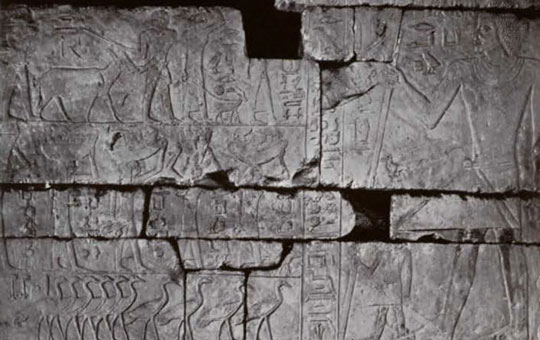
Vol. XVIII / No. 2
By: Cornelia H. Dam
The Tomb Chapel of Ra-Ka-Pou: A Court Official of 2650 B.C.
THE Fifth Dynasty Tomb of Ra-Ka-Pou from Saqqara was sent to this country by the Egyptian Government for the St. […]
View Article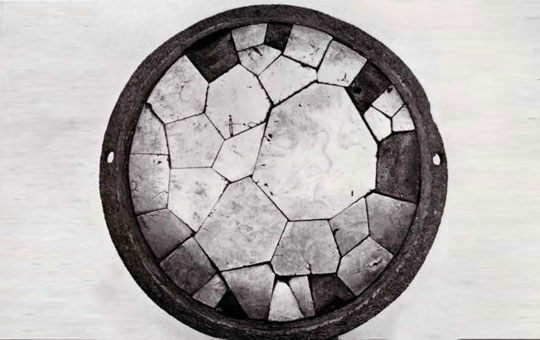
Vol. XVIII / No. 2
By: Dr. J. Alden Mason
Mirrors of Ancient America
THE idea of a mirrorless world is far from being a purely hypothetical one; the human world was without mirrors […]
View Article
Vol. XVIII / No. 3
By: L. Legrain
Sumerian Sculptures
ARCHÆOLOGISTS in the field have many hard days, but they have also a delightful reward when out of the trenches […]
View Article
Vol. XVIII / No. 3
By: J. Alden Mason
Eskimo Pictorial Art
THE Eskimo have always been a subject of the highest interest, not only to the popular mind, but also to […]
View Article
Vol. XVIII / No. 3
By: Helen E. Fernald
A Chinese Buddhistic Statue in Dry Lacquer
ONE of the most striking objects in the Chinese collections of the Museum is the strange statue of a Buddha, […]
View Article
Vol. XVIII / No. 3
By: H. U. Hall
Dwarfs and Divinity in West Africa
THIS grotesque figure in high relief on what remains of a small shieldlike bronze plaque has certain well marked characters […]
View Article
Vol. XVIII / No. 4
By: L. Legrain
Tomb Sculptures from Palmyra
PALMYRA1 in the desert is a magnificent ruin, a dead city, only known in our MUSEUM through some funerary monuments; […]
View Article
Vol. XVIII / No. 4
By: J. Alden Mason
What We Know About The Maya: (From a Lecture delivered at the Museum on November 13th)
THE land of the Maya nation in Guatemala and the surrounding countries of Yucatan, southern Mexico, Salvador, and northern Honduras […]
View Article
Vol. XVIII / No. 4
By: H. U. Hall
Two Masks From French Equatorial Africa
THE masks figured here belong to a clearly defined West African type of which only a few examples are to […]
View Article
Vol. XVIII / No. 4
By: Alan Rowe
The Expedition at Beisan
THE excavations which have been conducted annually since 1921 at Beisan, the biblical Bethshan, by the Museum of the University […]
View Article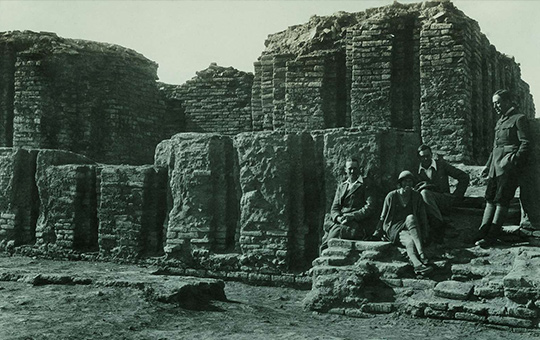
Vol. XVIII / No. 4
By: L. Legrain
Discovery of Royal Tombs at Ur of the Chaldees
YEAR after year the excavations at Ur of the Chaldees seem to become more important and interesting. But the discovery […]
View Article
Vol. XIX / No. 1
By: C. Leonard Woolley
The Royal Tombs of Ur of the Chaldees
THE discovery of royal tombs at Ur of the Chaldees is the out-standing feature of the sixth campaign of the […]
View Article
Vol. XIX / No. 1
By: Helen E. Fernald
The George Byron Gordon Memorial Collection
MR. ELDRIDGE R. JOHNSON has recently presented to the Museum in memory of Dr. George Byron Gordon, its late Director, […]
View Article
Vol. XIX / No. 1
By: Edith H. Dohan
Recent Additions to the Collection of Greek Vases
A Bronze Age Cup Decorated with an Octopus NO one can travel far in the Eastern Mediterranean without encountering the […]
View Article
Vol. XIX / No. 1
By: H. U. Hall
A Maori Feeding-Funnel
IN the MUSEUM JOURNAL for December, 1920, a number of objects illustrating the native decorative art of New Zealand were […]
View Article
Vol. XIX / No. 2
By: Helen E. Fernald
Another Fresco from Moon Hill Monastery
JUST north of the Yellow River and crossing nearly at right angles the main trunk line from Peking to Hankow […]
View Article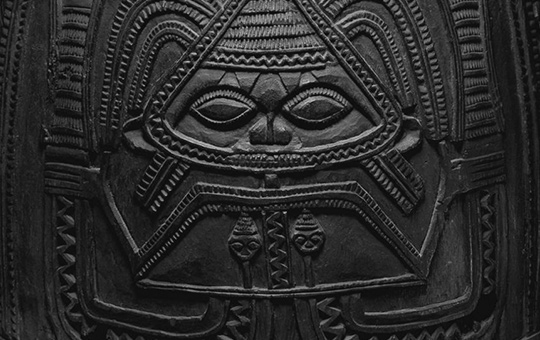
Vol. XIX / No. 2
By: H. U. Hall
A Large Drum From Benin
THIS large wooden drum from the kingdom of Benin was acquired by the UNIVERSITY MUSEUM several years ago and constitutes […]
View Article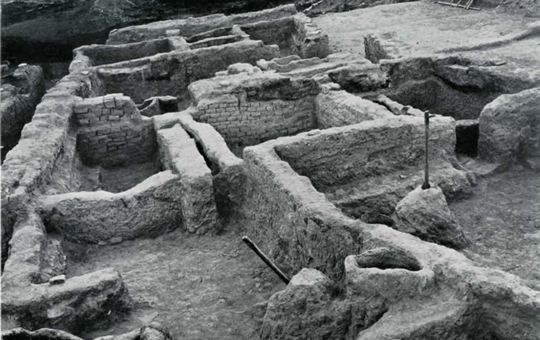
Vol. XIX / No. 2
By: Alan Rowe
The 1927 Excavations at Beisan: Final Report
IN my last report I described the eight main levels on the tell in which excavations were made at the […]
View Article
Vol. XIX / No. 2
By: J. Alden Mason
A Remarkable Stone Lamp from Alaska
THE archaeologist of a museum is presumed, above everything else, to be acquainted with all types of specimens and artefacts […]
View Article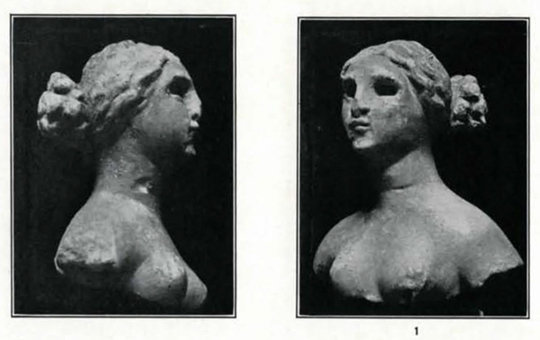
Vol. XIX / No. 2
By: L. Legrain
Small Sculptures from Babylonian Tombs
ORIENTAL cults were always familiar with the figure of the nude woman, the “funeral Venus,” whose images are found in […]
View Article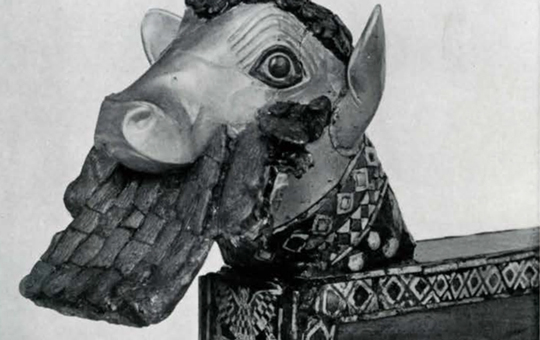
Vol. XIX / No. 3
By: L. Legrain
Old Sumerian Art
IT is a pure joy for a weary archaeologist to plunge into a study of Oriental art—the oldest known Mesopotamian […]
View Article
Vol. XIX / No. 3
By: Edith H. Dohan
Three Greek Grave Monuments
IN Greek thought as in Christian, it was held an act of virtue to bury the dead, or rather, since […]
View Article
Vol. XIX / No. 3
By: Helen E. Fernald
The T. Broom Belfield Collection of Japanese Netsuké
FOR flights of pure fun and fancy there is no field of art more prolific than that of the Japanese […]
View Article
Vol. XIX / No. 3
By: Cornelia H. Dam
An Egyptian Kursi
DURING the year 1923 the MUSEUM added to its Arabic collection an exceptionally fine kursi, or table, of brass inlaid […]
View Article
Vol. XIX / No. 3
By: J. Alden Mason
Some Unusual Spearthrowers of Ancient America
THE spearthrower is one of the most remarkable of the inventions of primitive man and for that reason has ever […]
View Article
Vol. XIX / No. 4
By: Helen E Fernald
Ladies of the Court: An Early Chinese Scroll Painting
THE MUSEUM has possessed for some years a Chinese scroll painting which professes to be by the hand of the […]
View Article
Vol. XIX / No. 4
By: Louis Shotridge
The Emblems of the Tlingit Culture
RECENTLY the MUSEUM placed on exhibition in the Tlingit Hall of the American Section a collection of objects, the greater […]
View Article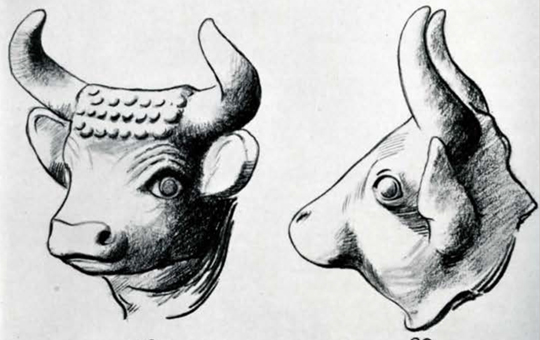
Vol. XIX / No. 4
By: L. Legrain
The Sumerian Art Shop
THE wonderful discoveries made in the royal tombs have been a revelation to many and have proved that old Sumer […]
View Article
Vol. XIX / No. 4
By: H. U. Hall
Twins in the Upper Guinea
FOR the present purpose, Upper Guinea may be taken, roughly, to mean the southern part of the westward extension of […]
View Article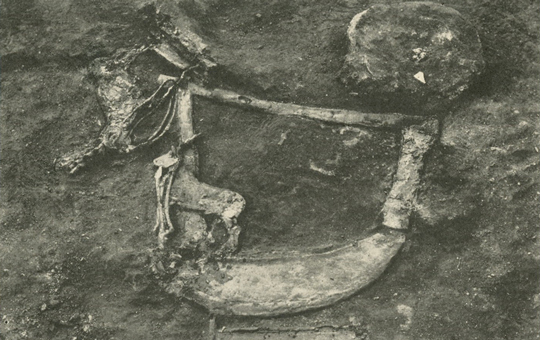
Vol. XX / No. 1
By: C. Leonard Woolley
Ur of the Chaldees: More Royal Tombs
THE discoveries of royal tombs at Ur by Mr. Woolley during the seventh campaign of the Joint Expedition have come […]
View Article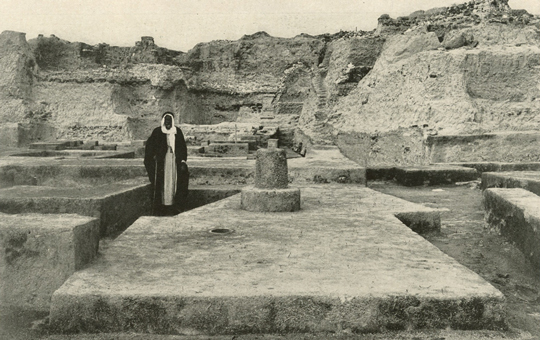
Vol. XX / No. 1
By: Alan Rowe
The Palestine Expedition: Report of the 1928 Season
THE excavations at Beisan, the ancient Beth-shan, were recommenced on August 27, 1928. The staff for the 1928 season consisted […]
View Article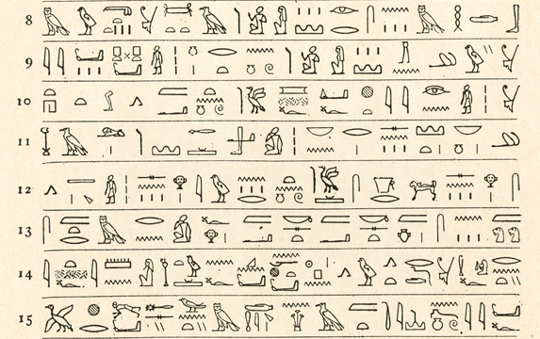
Vol. XX / No. 1
By: Alan Rowe
The Two Royal Stelæ of Beth-Shan
IN the MUSEUM JOURNAL for December, 1923, there appeared the photographs of the two large basalt stelæ discovered that year […]
View Article
Vol. XX / No. 1
By: L. L.
Note on the Inlay Standard
THE interpretation of the inlay standard in the MUSEUM JOURNAL of September, 1928, brought the following remarks from Mr. Woolley […]
View Article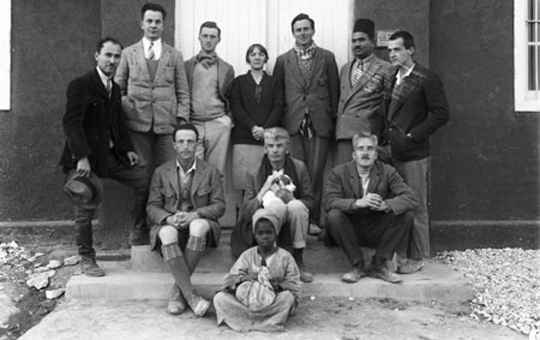
Vol. XX / No. 2
By: H. H. F. Jayne
A New Expedition to Egypt
THE MUSEUM is pleased to announce that it is about to resume archæological work in Egypt. An expedition has been […]
View Article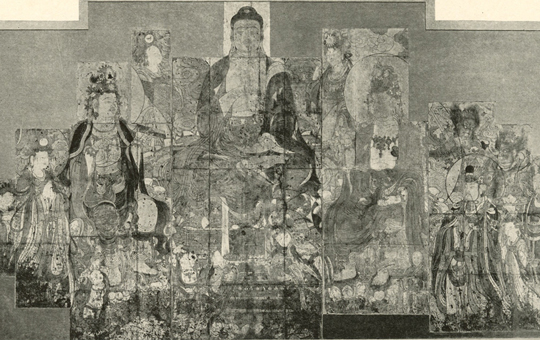
Vol. XX / No. 2
By: Helen E. Fernald
Two Sections of Chinese Fresco Newly Acquired: Belonging to the Great Kuan Yin Wall
TWO more portions of the huge wall painting from Yüeh Shan Ssŭ, near Ch’ing Hua Chen, have recently been acquired […]
View Article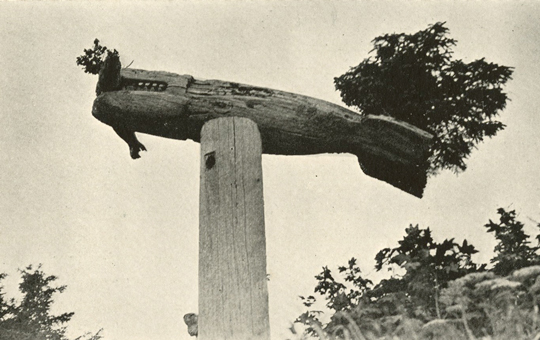
Vol. XX / No. 2
By: Louis Shotridge
The Bride of Tongass: A Study of Tlingit Marriage Ceremony
MARRIAGE was honorable in all, and it was about this association of man and woman that all the Tlingit life […]
View Article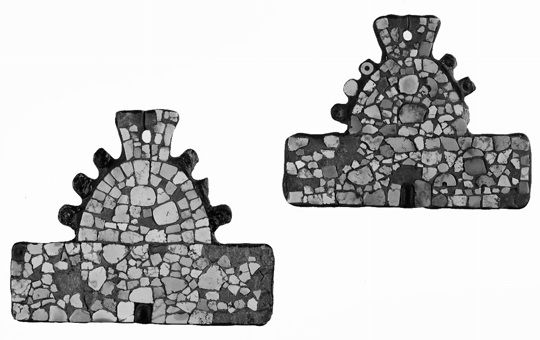
Vol. XX / No. 2
By: J. Alden Mason
Turquoise Mosaics from Northern Mexico
GEMS and semi-precious stones of rich colours or delicate translucency have forever attracted the esthetic sense of man; their use […]
View Article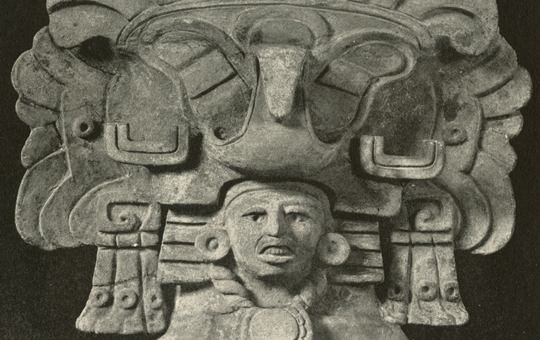
Vol. XX / No. 2
By: J. Alden Mason
Zapotec Funerary Urns from Mexico
THE average layman knows of but two great native civilizations in America, those of the Aztecs and of the Incas. […]
View Article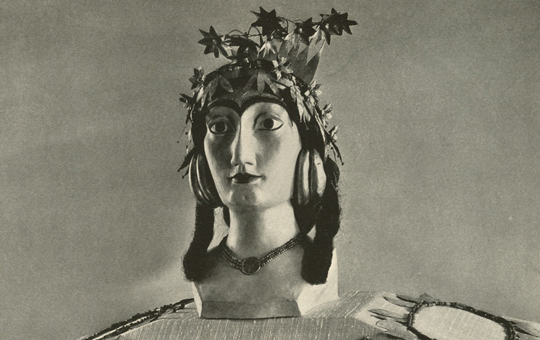
Vol. XX / No. 3-4
By: L. Legrain
The Boudoir of Queen Shubad
QUEEN SHUBAD was so fond of her jewels that when she died in ancient Ur, six thousand years ago, they […]
View Article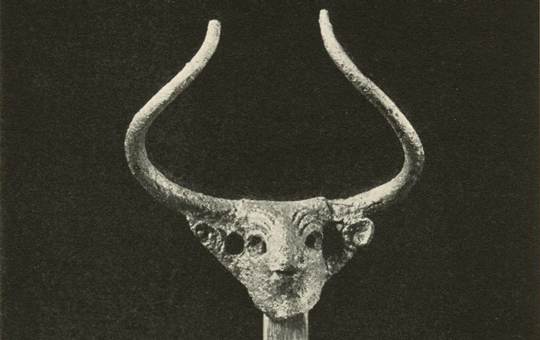
Vol. XX / No. 3-4
By: Kenneth Graham
Scientific Notes on the Finds From Ur
I. Restoration of the Silver THE metallurgists of early times, as is well known, were able to produce bronzes of […]
View Article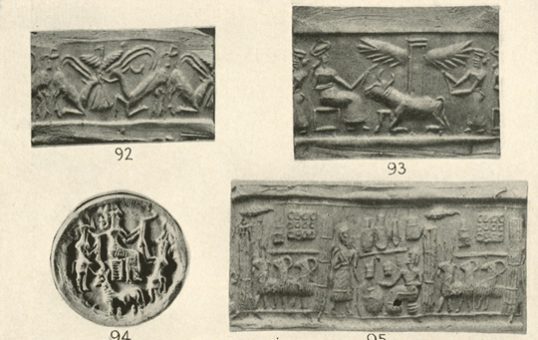
Vol. XX / No. 3-4
By: L. Legrain
Gem Cutters in Ancient Ur
“All the Babylonians,” says Herodotus, who visited the land in the days of Artaxerxes Longhand, “have a seal and they […]
View Article
Vol. XX / No. 3-4
By: D. S. Davidson
The Lock Haven Expedition
THE Lock Haven Expedition of the University Museum was organized in June, 1929, for the purpose of investigating the archæological […]
View Article
Vol. XX / No. 3-4
By: J. Alden Mason
The Texas Expedition
TEXAS, although the largest state in the Union, has been quite neglected by archæologists and therefore was chosen as the […]
View Article
Vol. XX / No. 3-4
By: Louis Shotridge
The Kaguanton Shark Helmet
AT last the Kaguanton Clan let go its oldest possession, the “Shark” Helmet (Plates XLVII and XLVIII). It is a […]
View Article
Vol. XXI / No. 1
By: Robert Burkitt
Excavations at Chocolá
CHOCOLÁ is a big coffee, sugar, and cattle estate, watered by a stream of the same name; and belongs geographically […]
View Article
Vol. XXI / No. 1
By: Robert Burkitt
Explorations in the Highlands of Western Guatemala
THE sites that I wish to speak of are at least six: Xoch, Chipal, San Francisco, Chichel, Nebaj, Xolchún. Xolchún, […]
View Article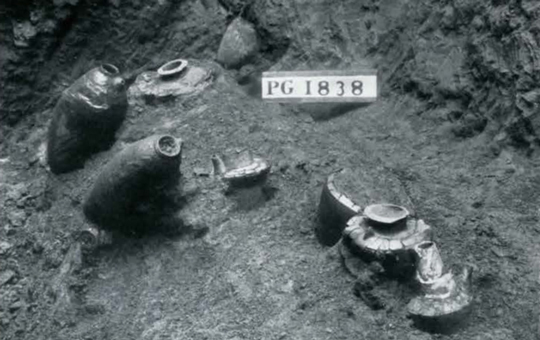
Vol. XXI / No. 2
By: C. Leonard Woolley, Litt.D.
Excavations at Ur, 1929-30
THE eighth season of the Joint Expedition of the British Museum and of the Museum of the University of Pennsylvania […]
View Article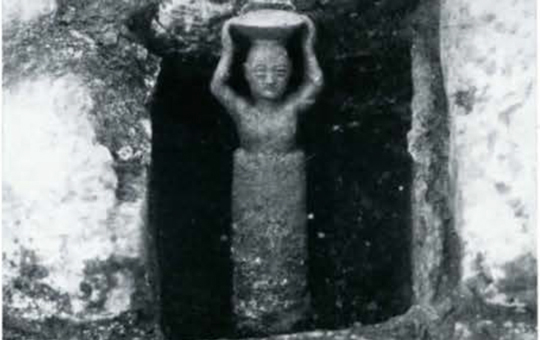
Vol. XXI / No. 2
By: E. Burrows
Appendix: Tablets and Seal-Impressions
The bulk of the material came from one site. The vertical southwestern side of the cemetery excavation showed a well-defined […]
View Article
Vol. XXI / No. 3-4
By: Charles Bache and Linton Satterthwaite, Jr.
Excavation of an Indian Mound at Beech Bottom
THE period from July 3 to August 4, 1930, was spent in the investigation of a small mound on the […]
View Article
Vol. XXI / No. 3-4
By: Edgar B. Howard
Archaeological Research in the Guadalupe Mountains
ALTHOUGH there has been extensive archaeological work carried on in the Southwest in recent years, much still remains to be […]
View Article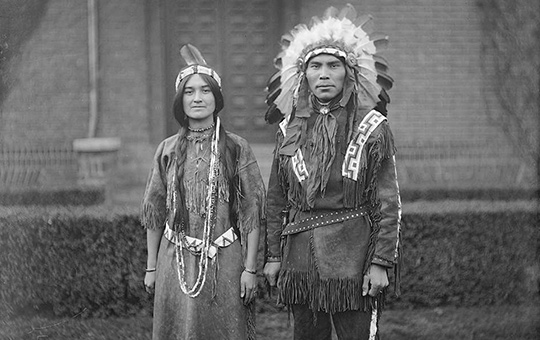
Vol. XXI / No. 3-4
By: Louis Shotridge
How Ats-ha Followed the Hide of His Comrade to Yek Land
YEK is a Tlingit term for the in-dwelling spirits of the elements—the earth, the air, the water, the frost and […]
View Article
Vol. XXII / No. 1
By: Alan Rowe
I. Introduction: The Eckley B. Coxe, Jr., Expedition Excavations at Meydûm, 1929-30
THE excavations carried out at Meydûm by the Coxe Expedition of the University Museum were begun on November 2, 1929, […]
View Article
Vol. XXII / No. 1
By: Alan Rowe
II. Chronological List of People Associated with Meydûm Since the Twelfth Century A.D.: The Eckley B. Coxe, Jr., Expedition Excavations at Meydûm, 1929-30
Title Reference 1117-1119 Makrizi and Abû-Mohammed Abdallah. Makrizt, an Arab historian (1364-1442), wrote: “There is another pyramid, called the ‘Pyramid […]
View Article
Vol. XXII / No. 1
By: Alan Rowe
III. The Site and Its Name: The Eckley B. Coxe, Jr., Expedition Excavations at Meydûm, 1929-30
The position of Meydûm in relation to the other pyramid sites of the Ancient Kingdom and the Middle Empire is […]
View Article
Vol. XXII / No. 1
By: Alan Rowe
IV. The Pyramid: The Eckley B. Coxe, Jr., Expedition Excavations at Meydûm, 1929-30
From the evidence afforded by the graffiti in its funerary temple [Plate XXXV, 2], it has been generally assumed that […]
View Article
Vol. XXII / No. 1
By: Alan Rowe
V. The Pyramid Temple, Silo, and Causeway: The Eckley B. Coxe, Jr., Expedition Excavations at Meydûm, 1929-30
A. The Pyramid Temple The temple on the eastern face of the pyramid discovered in 1891 by Professor Petrie was […]
View Article
Vol. XXII / No. 1
By: Alan Rowe
Bibliographical References: The Eckley B. Coxe, Jr., Expedition Excavations at Meydûm, 1929-30
Baedeker, K., editor, Ober Aegypten, second edition, 1891 Bergmann, E. V., in Recueil de Trarauz, VII, 179 Birch, S., Egypt […]
View Article
Vol. XXII / No. 1
By: Alan Rowe
Description of Plates: The Eckley B. Coxe, Jr., Expedition Excavations at Meydûm, 1929-30
PLATE I. Reconstruction of the Meydûm Pyramid Site, looking northwest and showing Seneferu’s pyramid, parts of the mastabah tomb of, […]
View Article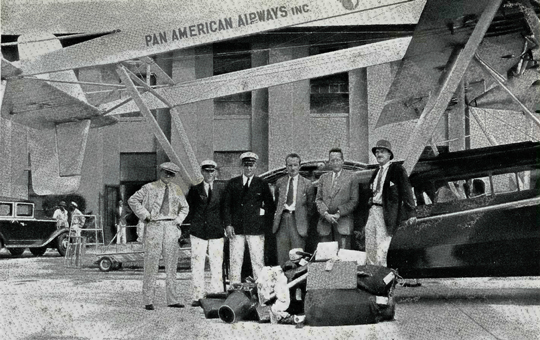
Vol. XXII / No. 2
By: Percy C. Madeira, Jr.
An Aerial Expedition to Central America
THE indigo water of the Caribbean deep, bordered with azure and emerald on the edges of its white coral shores; […]
View Article
Vol. XXII / No. 2
By: Mary Butler
Dress and Decoration of the Maya Old Empire: A Study of Stone Carvings with some Comparison of Corresponding Features on Pottery and Jades
I ALTHOUGH the monuments of the Maya Old Empire — monolithic stelae and altars, stone and wooden lintels—are few in […]
View Article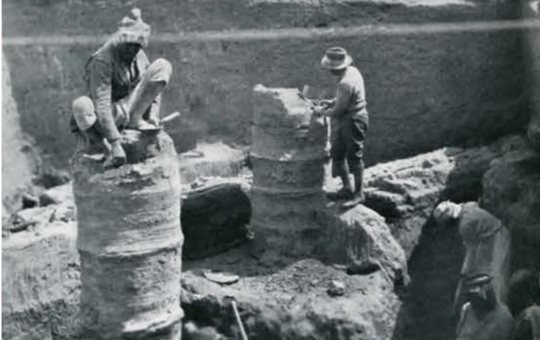
Vol. XXII / No. 3-4
By: Erich Schmidt
Excavations at Fara, 1931
[Note: The following report is printed just as it was received from Dr. Schmidt in the field. Being a preliminary […]
View Article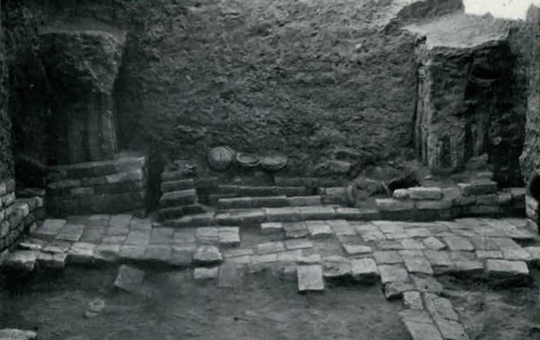
Vol. XXII / No. 3-4
By: C. Leonard Woolley
Excavations at Ur, 1930-31
THE Joint Expedition of the British Museum and the University Museum started its ninth season at Ur on November 1, […]
View Article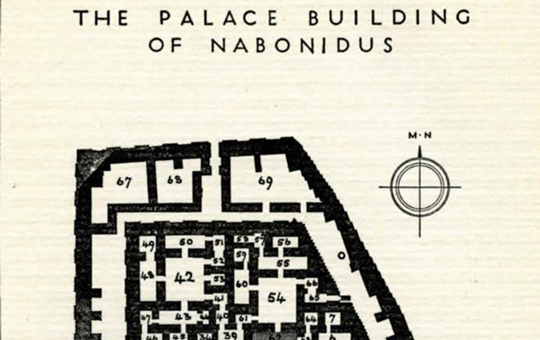
Vol. XXII / No. 3-4
By: M. E. L. Mallowan
The Palace Building of Nabonidus
In November 1930 the Expedition uncovered a mud-brick building with abnormally deep foundations on the north-east side of the ancient […]
View Article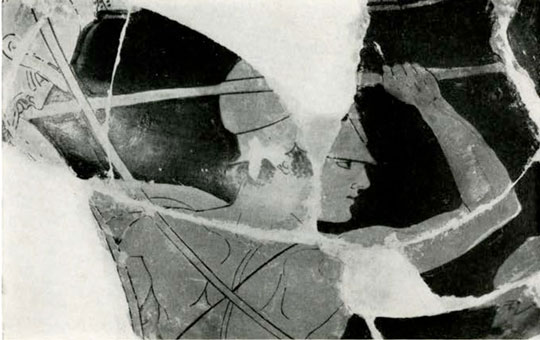
Vol. XXIII / No. 1
By: J. D. Beazley
Battle-Loutrophoros: Recent Additions to the Classical Collections
THE vase shown in Figures 1 to 17 is said to have been found at Athens. It has been reproduced, […]
View Article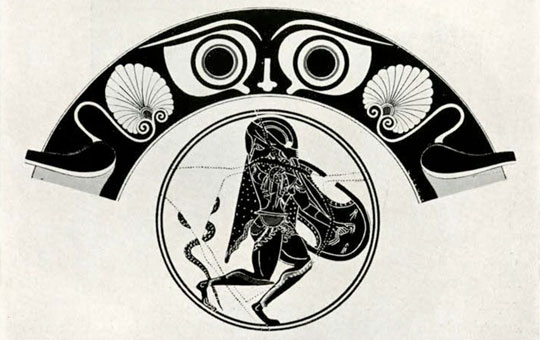
Vol. XXIII / No. 1
By: E. H. Dohan
Four Vases from the Henry C. Lea Collection: Recent Additions to the Classical Collections
IN THE collection of Greek vases made by the late Henry C. Lea, which, through the generosity of his family, […]
View Article
Vol. XXIII / No. 1
By: Valentin Müller
A Portrait of the Late Roman Empire: Recent Additions to the Classical Collections
THE fourth century A.D. marks a turning-point in the history of the Mediterranean World. Permanent war against invading barbarians, inner […]
View Article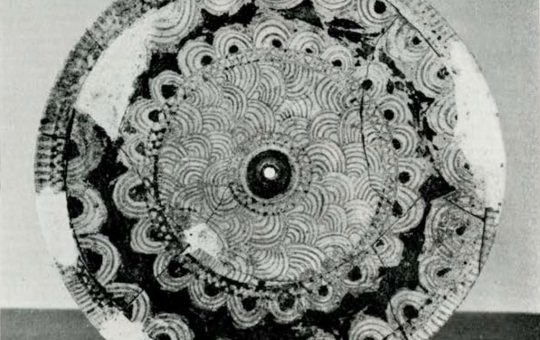
Vol. XXIII / No. 1
By: E. H. Dohan
A Late Minoan Pyxis: Recent Additions to the Classical Collections
IN 1930 the Museum purchased from Paris the delicately painted pyxis of Figure 1. The buff clay of which it […]
View Article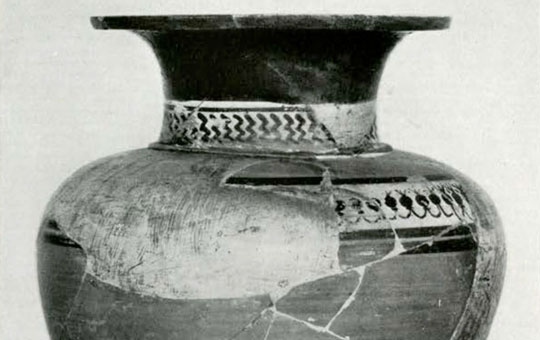
Vol. XXIII / No. 1
By: E. H. Dohan
A Lydian Imitation of a Laconian Vase: Recent Additions to the Classical Collections
In 1897, through the generosity of the late John Wanamaker, the Museum acquired a box of potsherds from Orvieto. To […]
View Article
Vol. XXI / No. 3-4
By: E. H. Dohan
Two Vases from the Hegeman Collection: Recent Additions to the Classical Collections
IN THE Spring of 1930, Miss Annie May Hegeman of Washington very generously lent to the University Museum three vases, […]
View Article
Vol. XXIII / No. 2
By: V. M. Petrullo
Description of Plates: Primitive Peoples of Matto Grosso
The italic number under each plate number indicates the page on which that plate will be found. (Frontispiece) Tsuva girl. […]
View Article
Vol. XXIII / No. 2
By: Vincent M. Petrullo
Primitive Peoples of Matto Grosso: An Account of Archaeological and Ethnological Field Work at the Headwaters of Paraguay and Xingu Rivers in Matto Grosso, Brazil, During 1931
THIS account of my field work in Matto Grosso, Brazil, during 1931, is offered to those interested in primitive peoples […]
View Article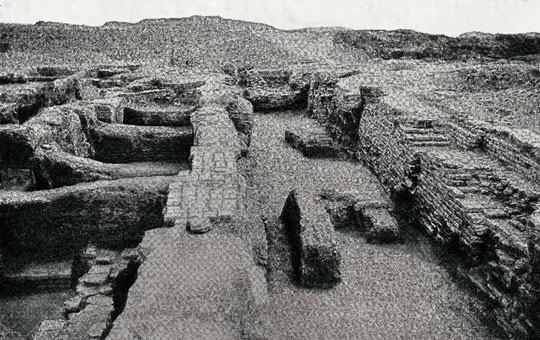
Vol. XXIII / No. 3
By: C. Leonard Woolley
Excavations at Ur, 1931-32
THE tenth season of the Joint Expedition of the British Museum and of the University Museum, Philadelphia, began work in […]
View Article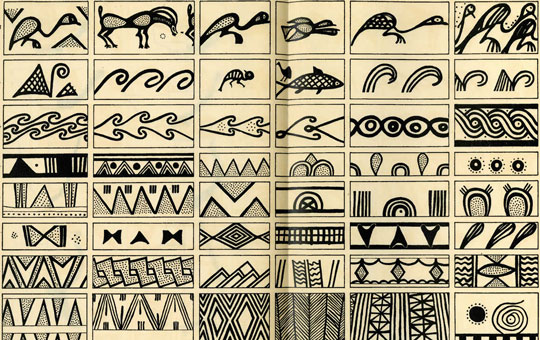
Vol. XXIII / No. 3
By: E. A. Speiser
The Pottery of Tell Billa: A Preliminary Account
Title reference IN October, 1930, the joint Assyrian expedition of the University Museum and the American Schools of Oriental Research […]
View Article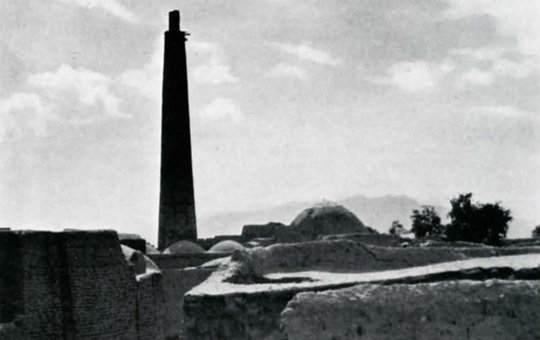
Vol. XXIII / No. 4
By: E. F. S.
Foreword: Tepe Hissar Excavations 1931
It is our pleasant duty to express gratitude to the patrons, counsellors, and friends of the Expedition, whose constant interest […]
View Article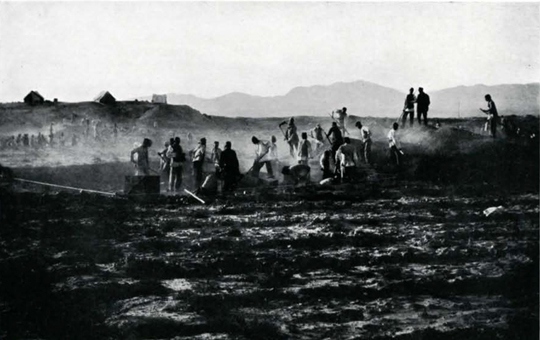
Vol. XXIII / No. 4
By: Erich F. Schmidt
The Expedition: Tepe Hissar: Excavations of 1931
The Aims of the Expedition It is the aim of every archaeological expedition to uncover remains of peoples and cultures […]
View Article
Vol. XXIII / No. 4
By: Erich F. Schmidt
Hissar I: Tepe Hissar: Excavations of 1931
The Stratum of the Painted Pottery About 3000 B.C., let us estimate, the present plain of Damghan already was settled […]
View Article
Vol. XXIII / No. 4
By: Erich F. Schmidt
Hissar II: Tepe Hissar: Excavations of 1931
The Stratum of the Early Gray Ware Again we are simply estimating in attributing the arrival of the Hissar II […]
View Article
Vol. XXIII / No. 4
By: Erich F. Schmidt
Hissar III: Tepe Hissar: Excavations of 1931
The Stratum of the Late Gray Ware The Iron Age began in Persia, according to our belief, during the second […]
View Article
Vol. XXIII / No. 4
By: Erich F. Schmidt
The Sasanian Palace: Tepe Hissar: Excavations of 1931
[Plates CLVI-CLXIX] We are convinced that the Damghan plain was settled rather continuously by towns or villages of varying importance; […]
View Article
Vol. XXIII / No. 4
By: Erich F. Schmidt
Summary and Results: Tepe Hissar: Excavations of 1931
Time had erased the memory of the dead towns of Tepe Hissar. About three and a half millennia after the […]
View Article
Vol. XXIII / No. 4
By: Erich F. Schmidt
Appendix: Tepe Hissar: Excavations of 1931
Season’s End, Interlude in Teheran Icy winds and occasional flurries of rain were already sweeping across the Damghan plain when, […]
View Article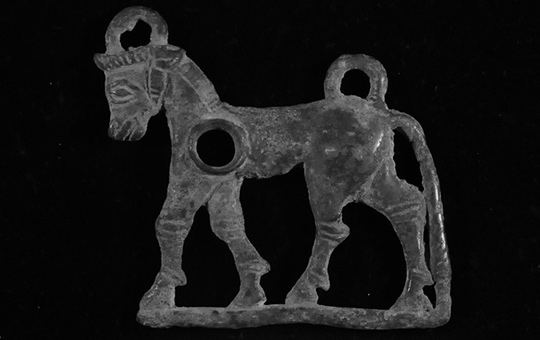
Vol. Supplement / No. 1934
By: Leon Legrain
Luristan Bronzes in the University Museum
A small but choice collection of Persian bronzes from Luristan was acquired in 1930 by the University Museum through Mr. […]
View Article
Vol. XXIV / No. 1
By: Gerald M. FitzGerald
The Earliest Pottery of Beth-Shan
IN the latter part of 1933 the tenth season of the excavations by the University Museum, Philadelphia, at Beth-shan was […]
View Article
Vol. XXIV / No. 1
By: Charles Bache
The First Assyrian Level at Tell Billa
Plan of Stratum I-ASS It must be emphasized that this plan should be regarded only as a factual recording of […]
View Article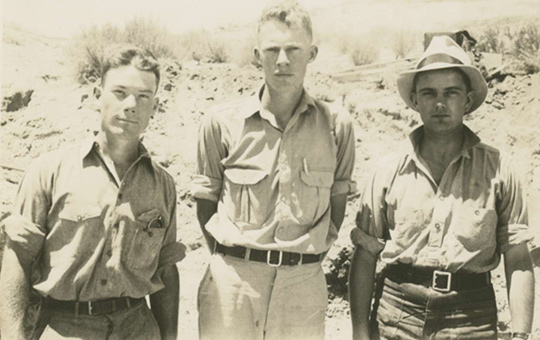
Vol. XXIV / No. 2-3
By: E. B. H.
Foreword: Evidence of Early Man in North America
Since 1929 most of the Spring and Summer months have been spent by the writer in field work, a large […]
View Article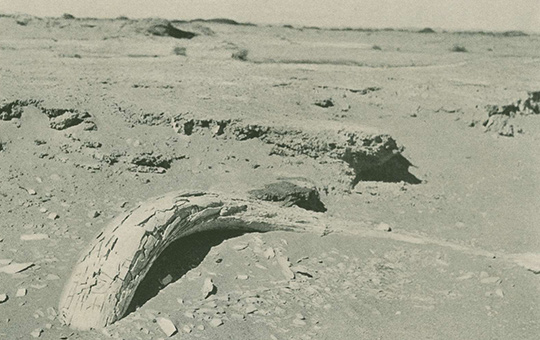
Vol. XXIV / No. 2-3
By: Edgar B. Howard
Introduction: Evidence of Early Man in North America
Based on Geological and Archaeological Work in New Mexico
Abstract Two occurrences in New Mexico—one in a cave and one in old lake beds—establishing associations of extinct animals and […]
View Article
Vol. XXIV / No. 2-3
By: Edgar B. Howard
Burnet Cave: Evidence of Early Man in North America
In any systematic search for evidences of early man, dry caves probably offer the best opportunity of finding such remains. […]
View Article
Vol. XXIV / No. 2-3
By: Edgar B. Howard
Clovis: Evidence of Early Man in North America
Having given the principal facts in connection with the work accomplished at Burnet Cave, we shall now consider the second […]
View Article
Vol. XXIV / No. 2-3
By: Edgar B. Howard
Geological Estimates: Evidence of Early Man in North America
In any investigation such as we are attempting, the use of certain geological terms is unavoidable, and since there is […]
View Article
Vol. XXIV / No. 2-3
By: Edgar B. Howard
Folsom and Related Artifacts: Evidence of Early Man in North America
As is inevitably the case when a new name comes into use to describe some specialized object of human workmanship, […]
View Article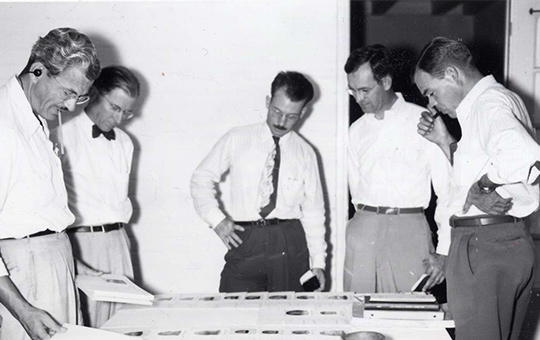
Vol. XXIV / No. 2-3
By: Edgar B. Howard
Migration Routes: Evidence of Early Man in North America
We have tried to assemble the latest interpretations of certain geological terms which are intimately connected with the problem of […]
View Article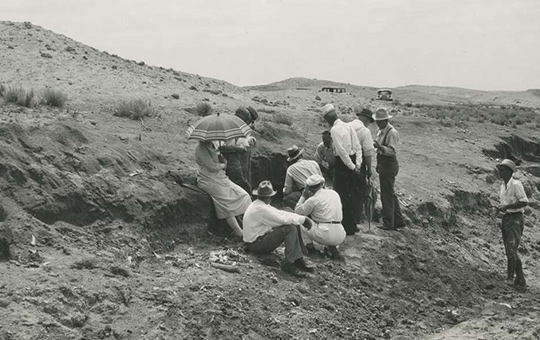
Vol. XXIV / No. 2-3
By: Edgar B. Howard
Anthropological Discussion: Evidence of Early Man in North America
This brings us to a consideration of what the physical anthropologists have to say about the affinities of the early […]
View Article
Vol. XXIV / No. 2-3
By: Edgar B. Howard
Summary and Conclusion: Evidence of Early Man in North America
Thus we see that evidence has accumulated in recent years to make acceptable certain facts in connection with the problem […]
View Article
